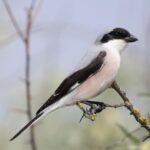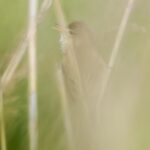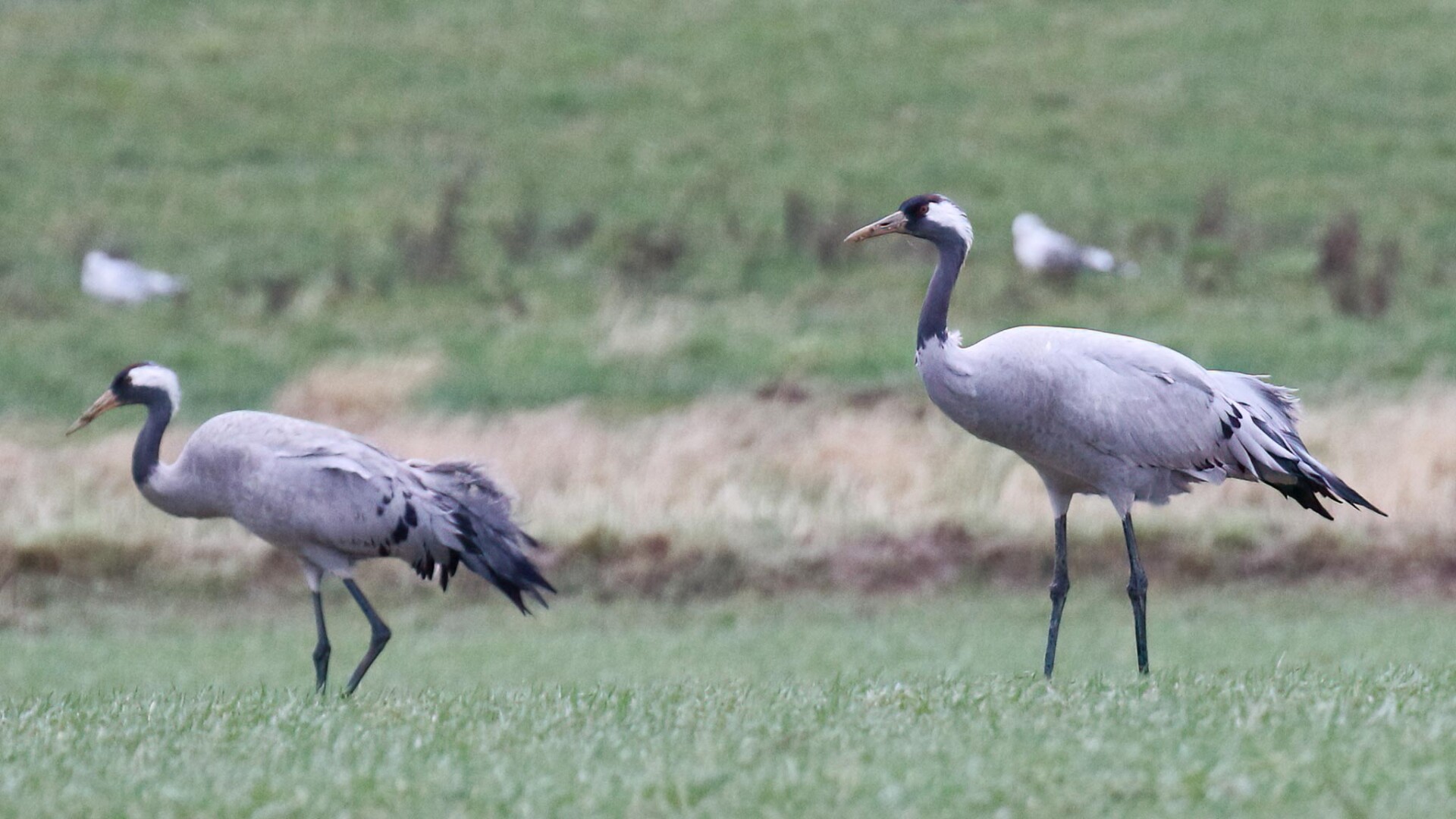An International Tour organised in conjunction with our friends at Oriole Birding. A short trip, looking for woodpeckers and owls, and timed to catch the wintering Steller’s Eiders before they head off north. We will be looking to run this tour again, so if you like what you read, please get in touch.
FRIDAY 15TH MARCH
Mainly a travel day today. It was an early start, meeting at the Wizz Air counter at Luton Airport at 4am for our 6.10am flight to Tallinn. The plane took off on time and only took a couple of hours, so we arrived half an hour ahead of schedule. Our bags were already waiting for us on the carousel when we got through immigration and we met Tarvo, our local guide, in the Arrivals hall. There was light drizzle outside as we loaded up the minibus and on the short drive over to the café where we were going to have lunch, Tarvo rang ahead to say we would be early. There were a few Scandinavian Herring Gulls and Hooded Crows around the buildings on the way. After a short break for lunch, we were on our way again and soon we were out of Tallinn and into the countryside. We added a few more common birds on the way, a few Magpies and one or two Ravens, and a small wood by the road held several Grey Herons as we passed.
We turned off the main road at Padise and we could see lots of swans in the fields even before we pulled over at the start of a track where we could stop and get out. Three White-fronted Geese flew over calling. It was rather misty, but getting the scopes out we could see that the fields were full of geese, as well as about 400 Whooper Swans. The geese were mainly Tundra Bean Geese, an impressive flock, Tarvo estimated around 1,200, with perhaps a hundred or so White-fronted Geese mixed in. We scanned through the geese to see if we could find anything different in with them, finding one or two Pink-footed Geese although they were hard to see in the mist and they kept disappearing into furrows in the field.
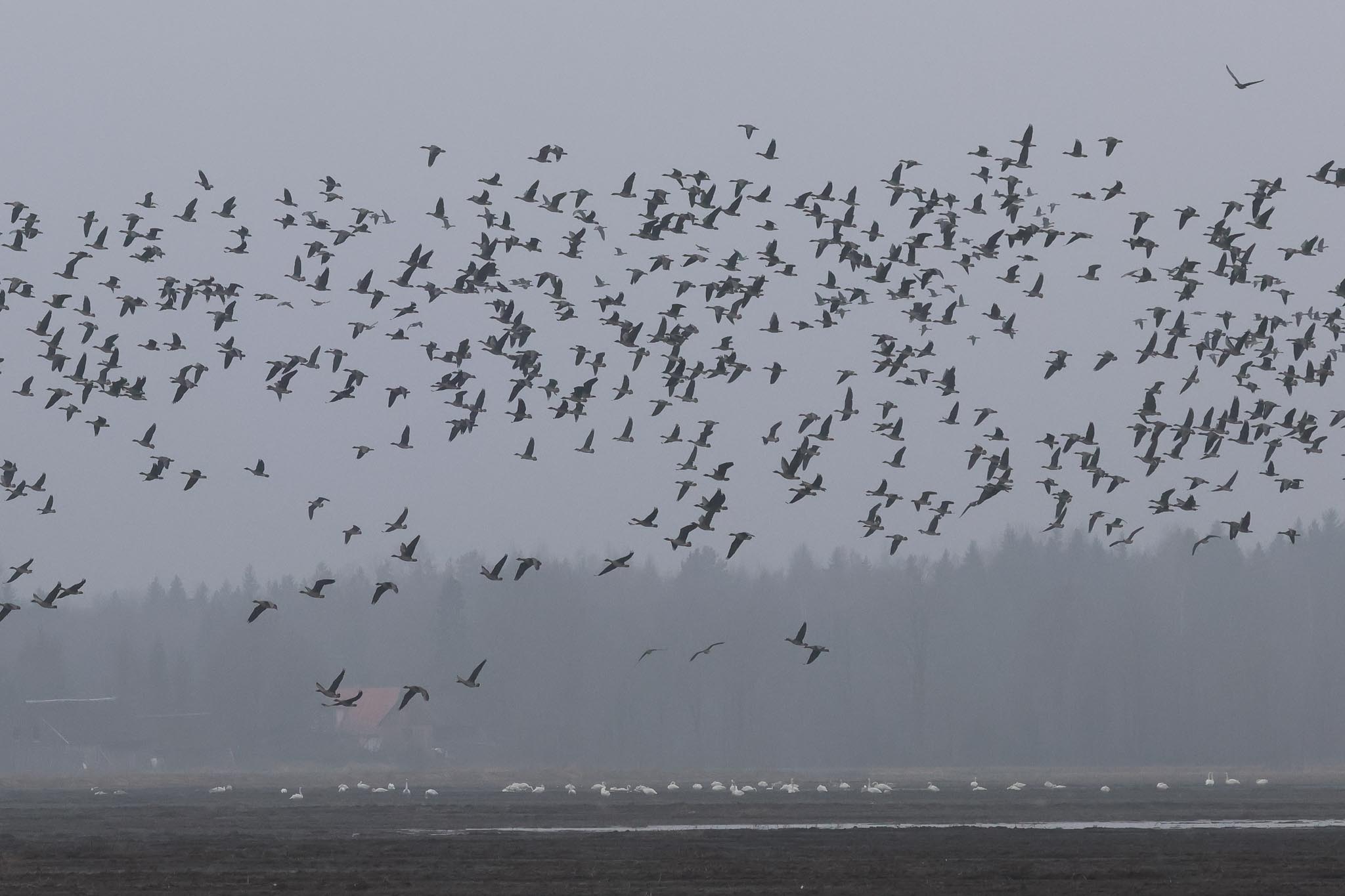
When all the geese flushed, we looked over to see a young White-tailed Eagle flying over the trees behind. The geese landed again, a little closer, so we could get a better look at the White-fronted Geese in particular. A Sparrowhawk shot past too, low over the field in front of us. The wet grassy field the other side of the road was full of Lapwings and several Skylarks were fluttering up singing or chasing round low over the ground. We heard a Golden Plover call overhead but couldn’t see it in the low cloud. A flock of thirteen Woodpigeons flew up and circled round before dropping down again – a summer visitor here, they are only just starting to return and this was the largest group Tarvo had seen yet this spring.
Moving on, we pulled up again on the side of the road when one of the group spotted three Common Cranes in a field. They have returned early this year and, unusually for here, these were two adults with a still attendant juvenile – the juveniles do not normally return with the adults in the early spring. When the female and juvenile took off, another pair of Cranes appeared in the sky too as they flew across the road. A little further on, when a few small birds came up out of a stubble field we stopped for a closer look and a huge flock of at least 500 Skylarks came up off the ground. Impressive numbers, and a reminder of how few we see in farmland in the UK these days. We were a little early still, so we drove on past the turning to our accommodation, to have a quick look at some nearby meadows. There was another pair of Cranes here and we stopped to watch them, as they started to bugle and then even a little bit of dancing. We found our first pair of Greylag Geese too. Then we looped round and back to Roosta and checked into our accommodation for the night.
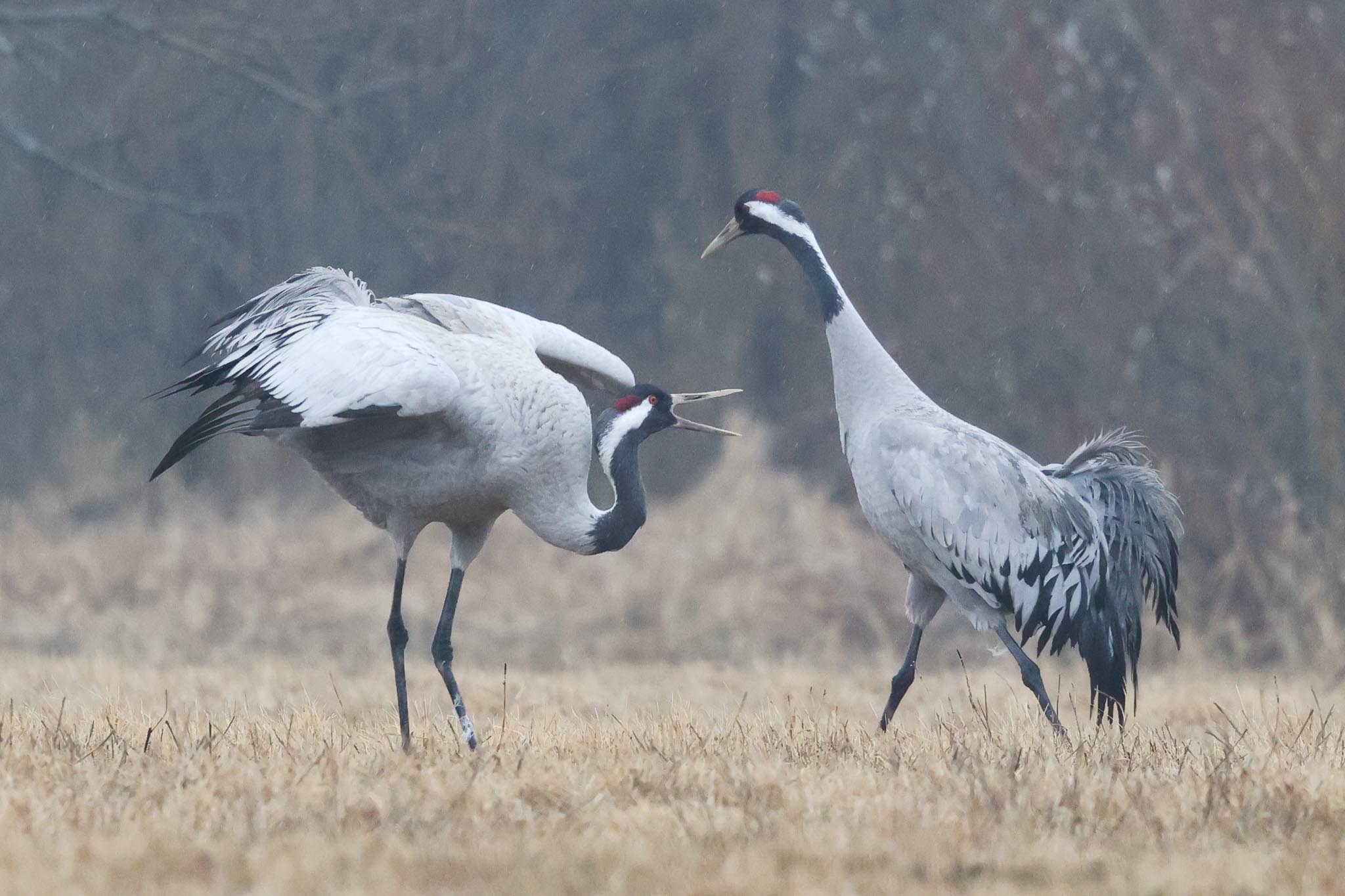
After a short break to get settled in, we met again at the minibus. As we drove through the forest, the drizzle at least seemed to be stopping, even if it was still rather misty in the trees. A Moose, or more properly an Elk this side of the Atlantic, appeared out of the trees and ran out across the road in front of us, followed by a second, impressively big even though they were two youngsters, and they disappeared quickly into the trees the other side despite their large size. We stopped by a small clearing and got out. We were hoping to find Ural Owl here, but we were perhaps a bit early still, as it was still quite light. A Common Buzzard flew across as we got out of the minibus, a Common Crane came high overhead and a Crested Tit called from the pines behind us but remained well hidden – we just had a couple of glimpses of a bird flying through the tops. We decided to drive on and come back a little later.
There had been a Hawk Owl not far away up to about a week ago and although it hadn’t been seen since, we decided to have a quick look. It was not really the weather for it, grey, misty and damp with a fresh wind and scanning the trees we couldn’t see any sign of it. We did start to find small groups of Roe Deer out in the fields now (Lynx food!). There were more Greylag Geese and another flock of several hundred Tundra Bean Geese flew up and circled round before whiffling back down. Another Common Buzzard was perched in a tree and another Sparrowhawk flew across. Away from the more open fields, we saw three male Yellowhammers perched on the telegraph wires by the track in quick succession. We went back to have another try for the Ural Owl but even though it was starting to get slightly darker, the wind seemed to have picked up further and it was still damp and cool – not great weather for owls. We could hear a Mistle Thrush singing now and two flew over, a Blackbird called from the bushes, and we could hear more Cranes bugling in the distance, but beyond that there was little activity here. It was almost time for dinner so we decided to head back to warm up.
SATURDAY 16TH MARCH
We set off at 7am for a quick look at a nearby site for Pygmy Owl, about ten minutes’ drive away. It was dry this morning, but still very grey and cold with the rather blustery wind from last night still blowing over the forest. As we got out of the minibus, some Siskins were calling in the trees and a Linnet flew over. We walked up the road listening for any owls but it was rather quiet in the forest. We did find a pair of Crested Tits, which came into the trees by the road and one dropped down where we could get a closer look. There were a few geese flying over further up and we could hear White-fronted Geese and Tundra Bean Geese calling. Some small groups of Skylark and Lapwing came over the forest and over the road too. We continued on a little further but there were no owls calling so Tarvo went back for the minibus. While we waited, we heard a mixed tit flock close to the road, including Great Tit and Marsh Tit, but they remained too deep in the spruces to see.
As we came back out into a clearing, a Great Grey Shrike was perched on the wires. We stopped to look at it and it dropped down, chasing after something and landing in a low fir tree close to the road. A flock of 20 Common Cranes flew over the trees behind. We still had time for another stop before breakfast, so we drove round to another clearing. It was a bit more sheltered from the wind here and immediately there was more activity. As we pulled up, a Woodlark flew up from the ground, across the road in front of us and off over the trees beyond. As we got out, a small group of Blackbirds came out of the bushes, presumably early migrants which had dropped in here overnight, and a couple of small flocks of Chaffinches flew over the trees behind.
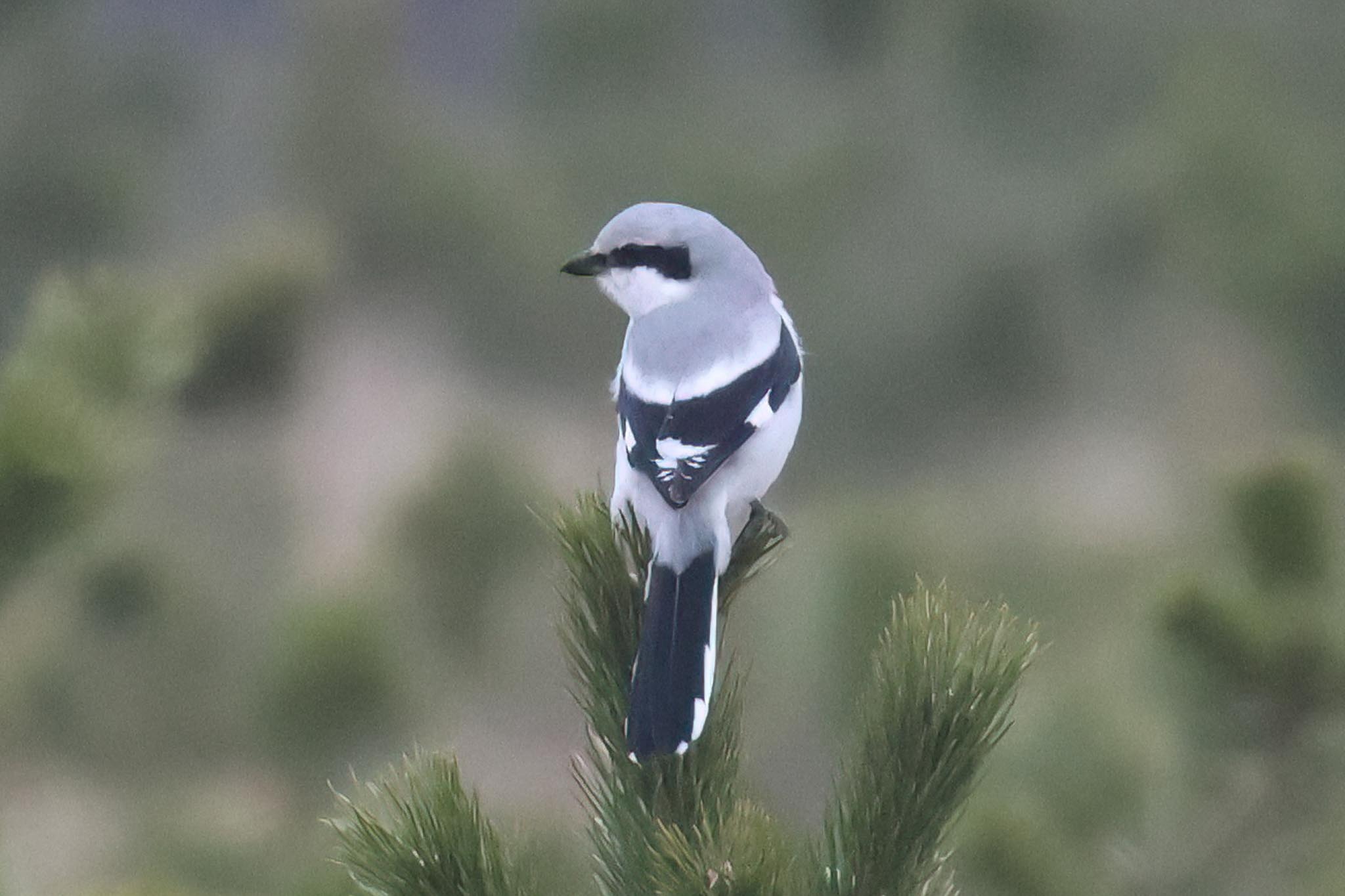
A Nutcracker called not too far away and quickly flew in and perched on the top of a nearby spruce. It was chased off its perch by a second Nutcracker, but they just dropped into some nearby deciduous trees where we could still see one preening before it flew up into the top of another spruce. We had a great look at it in the scopes now.
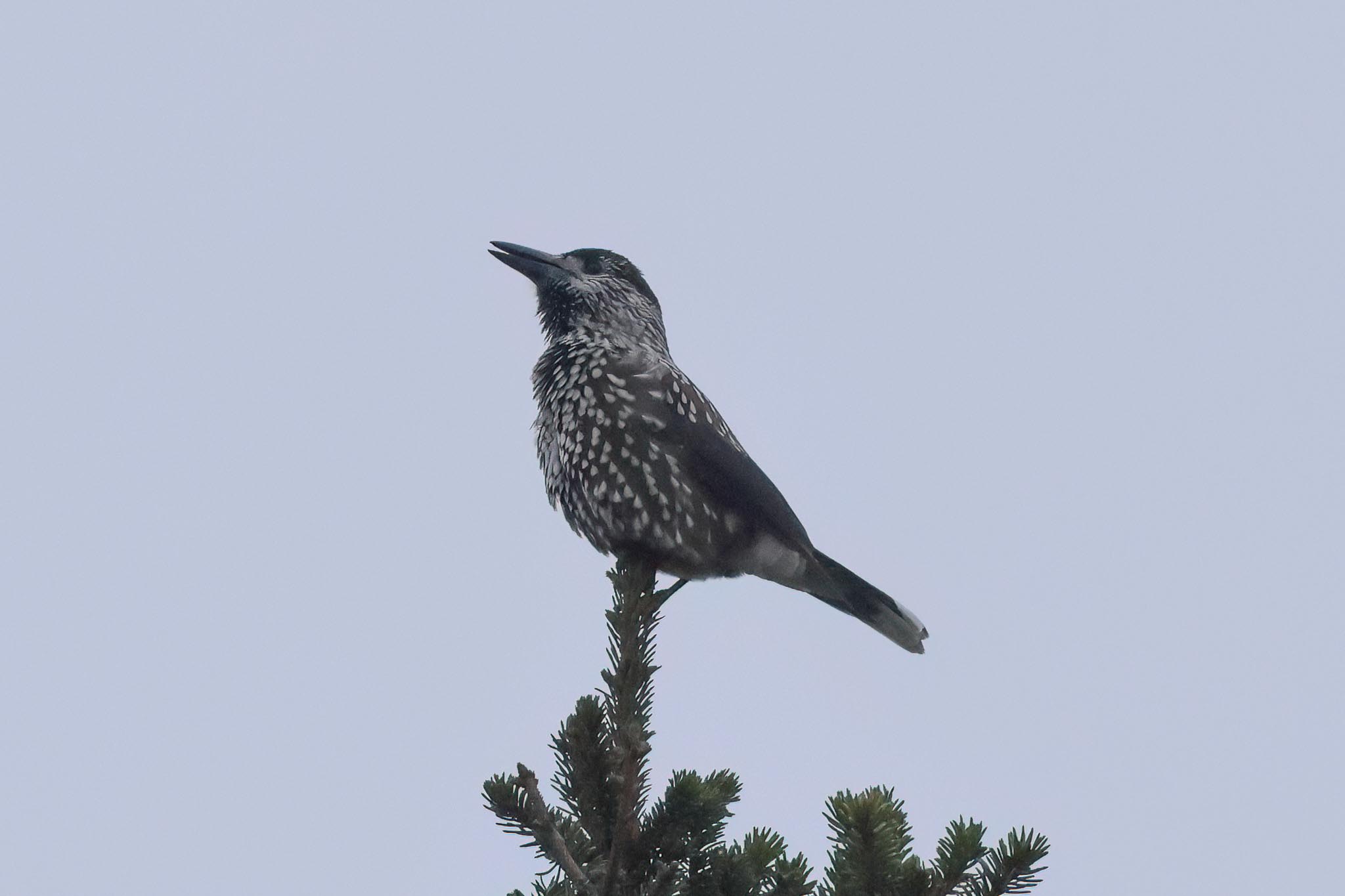
While we were watching it, we heard a Willow Tit calling nearby and it flew in to some small trees in the clearing closer to us where it started singing. The Willow Tits here are of the northern race, borealis, which is noticeably paler than the British race. A Great Spotted Woodpecker flew in and landed on a bare dead pine where we watched it feeding on the old cones. The Nutcracker was still in the top of the spruce, so we turned our attention back to that until it finally flew off, and then it was time to head back for a well-earned breakfast.
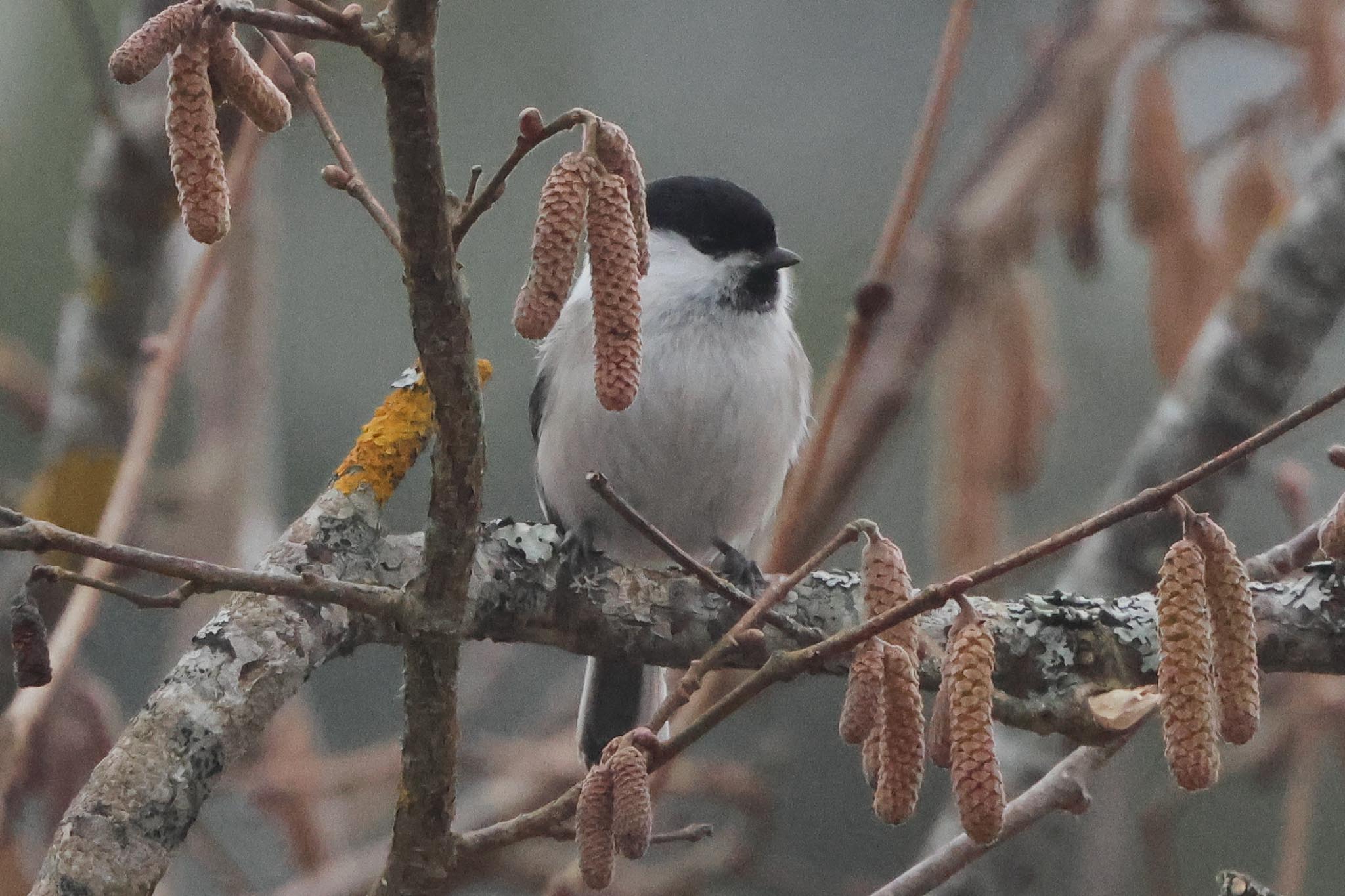
After breakfast, we packed up our bags and as we were loading up the minibus, three Common Crossbills flew over calling. We would be driving over to Virtsu to catch the ferry today and crossing over to the island of Saaremaa later, but we had several birding stops planned on the way. Driving through the fields we found more flocks of Lapwings with several Starlings feeding in with one of the largest ones and we flushed another Great Grey Shrike up from the verge. As we got down to the coast, we could see the bays were mostly still frozen. A White-tailed Eagle was perched on a rock down by the ice and in one area of open water we could see lots of ducks, mainly Goldeneye and Goosander, with several Grey Herons and Great White Egrets along the shore.
We were heading for Haapsalu first, and as we got closer and into the town we started to find more Rooks and Jackdaws which looked to be of the eastern race soemmerringii, with a distinctive pale collar. We parked by the promenade around the bay, which had a large area of open water now, and set up the scopes. We were quickly on to several Smew, including some smart drakes, not far offshore and further out we could see more, probably at least 60 in total. There were lots of Goosander, including a group of three in a hole in the ice close in, Goldeneye, and some large rafts of distant Tufted Duck. A pair of Gadwall were asleep on the ice out in the middle and several Wigeon were flying round and landing with the Mallard very distantly over on the far side.
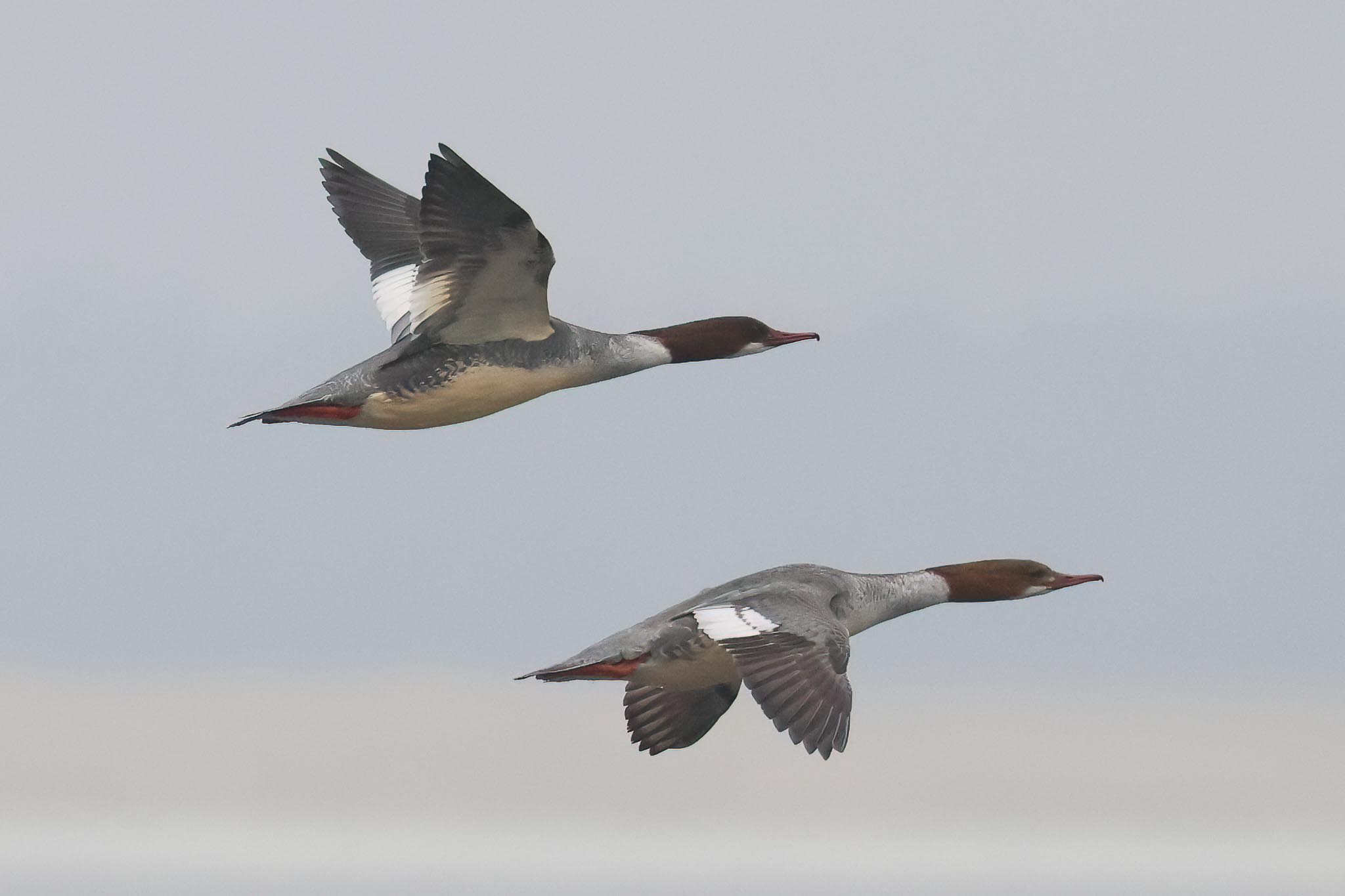
There were lots of swans too, good numbers of Mute Swans closer in and mainly Whooper Swans further out but also about 130 Bewick’s Swans only recently returned, stopping off on their way back to Russia and as we were watching another group of 33 flew in across the bay.
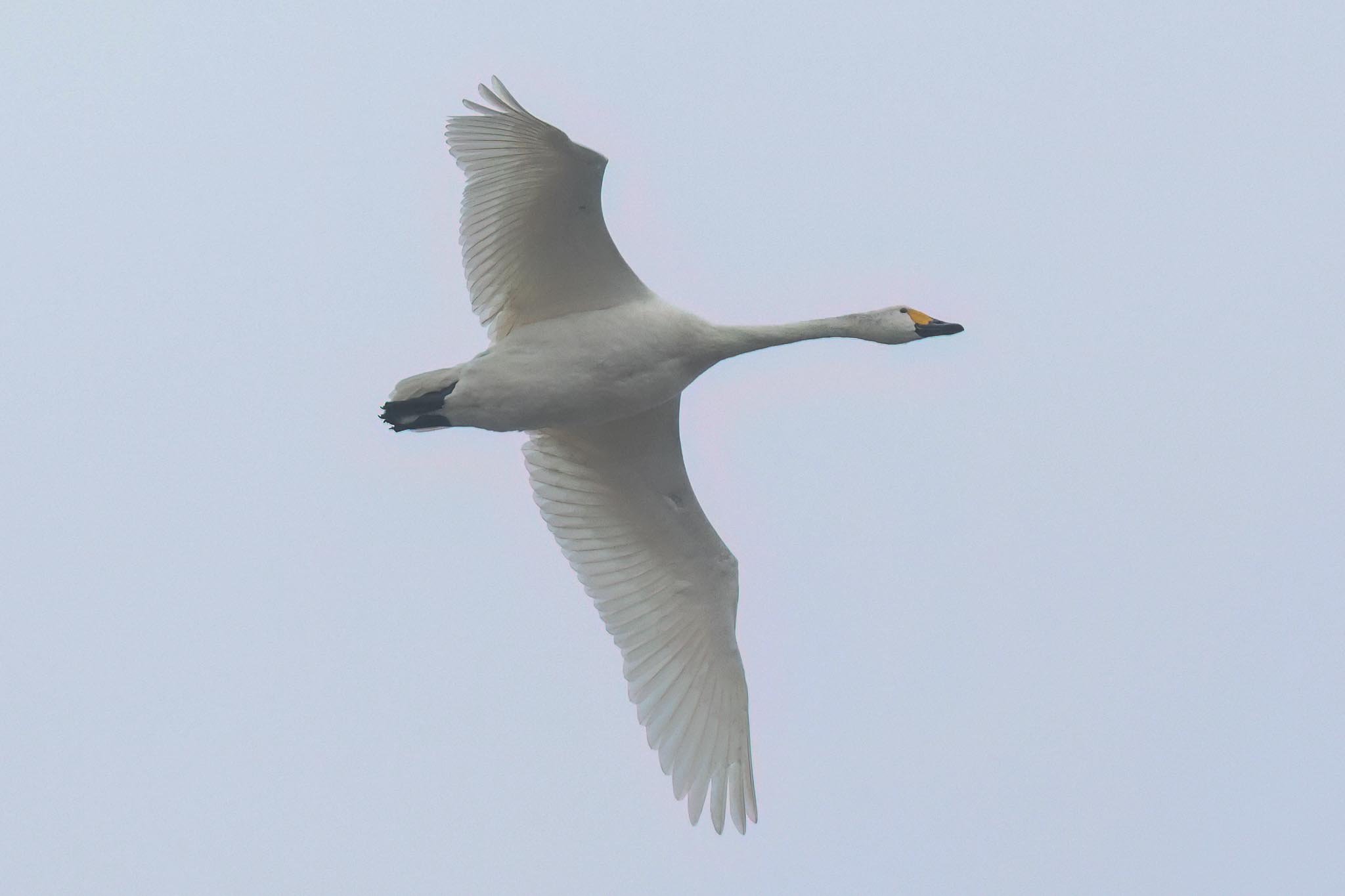
Closer to the town, there was a large raft of Coot and a big gathering of Cormorants, and there were a few gulls flying round, Black-headed, Common, Great Black-backed and Scandinavian Herring Gulls. All the latter we could see were of the localised race omissus which is distinct in having yellow legs. A Reed Bunting was calling from a small area of reeds in the ice and four more flew over, and we could hear a Greenfinch wheezing from the houses behind us and then looked over to see two males drop down onto the grass fighting. Then a couple of White-tailed Eagles appeared over the far side of the bay, an adult and a juvenile and we watched them catch what was possibly the same large fish several times, before the adult eventually took it to the ice to eat. The juvenile waited patiently nearby while one of the local Hooded Crows tried to steal bits from between the eagle’s legs.

When we could eventually tear ourselves away, we climbed back in the minibus and on our way over to Haeska where we would be having lunch, we stopped again to try for woodpeckers. A mixed tit flock appeared first, and as well as the Great Tits and Blue Tits there were a couple of Marsh Tits and a pair of white-headed Northern Long-tailed Tits (of the distinctive subspecies caudatus) – very smart birds and sometimes hard to catch up with here, we had some great views of them as they dropped down into some low alder scrub by the road.

There were a couple of Nuthatches too, again of a different race here, europaea, which are much whiter below than the ones we see normally back in the UK, and they flew in and started calling in the trees above us. We were then distracted when a Lesser Spotted Woodpecker flew in too. It was joined by a second and at first we thought they might be a pair, but then we realised both were males with red crowns as they attacked each other, spiralling round and dropping down towards the ground, before they eventually broke off and flew back up into the trees.

We stopped for lunch at a farm in the middle of nowhere. As we pulled in, a White-tailed Eagle flew off over the fields. The owner came out to meet us and led us to a beautifully converted barn where we were served a wonderful stew of beef and pork with roasted vegetables and wild mushroom salad, accompanied by a selection of homemade mustards of different flavours, followed by a delicious cheesecake made with spruce tips and dried cornflower petals.
After lunch, we stopped for ten minutes to try for White-backed Woodpecker in another small wood by the road but it was all quiet apart from a Great Grey Shrike which flew off ahead of us when we got out and walked along the back edge, so we drove on towards Virtsu. A Rough-legged Buzzard on a fence post by the road prompted another, unscheduled stop. We had to turn round and were just watching it from the minibus when it flew across a field and landed in a small tree a bit further back, so we could get out and have a proper look at it in the scopes.

Closer to the ferry, we turned off the road again onto another track and stopped again a bit further down next to a block of trees. It was not long this time before we heard Grey-headed Woodpecker calling and shortly after one flew in and landed in a tree right above the road, where it was joined by a second. A Great Spotted Woodpecker was also calling and drumming nearby. We carried on round through the fields, noting a couple of Yellowhammers and a Reed Bunting which flew off ahead of us, but there was no sign of any Black Grouse this afternoon.

Then we were back out onto the main road from where it was just a short drive on to the ferry terminal. There were a few Goldeneye and Goosander in the harbour but it quickly got very grey and gloomy now and then started to rain. We were quickly on board the ferry and almost before we could get up from the car deck we were underway on the short journey across to Muhu. It was very misty and hard to see much but we did pick up a few distant Long-tailed Ducks on the crossing.
We had a long drive over to the island of Saaremaa and our base for the night across the far side, so it was less of a problem that it was raining steadily now, although we did see one or two things on the way – notably an adult White-tailed Eagle on the ice as we crossed the causeway from Muhu. Once we got past the main town of Kuressaare, the rain stopped but it was still very misty and as we approached our destination we started to find more geese in the fields again, mainly White-fronted Geese and Greylags. We arrived at Loona Manor, our base for the next couple of nights, just before 6.30pm and after checking in and a break to settle in, we met again for another delicious local dinner.
SUNDAY 17TH MARCH
A short trip out before breakfast to try for Pygmy Owl, it was still dark when we met outside at 6am. It was dry and still, even if a bit misty again, much better weather for owling. It only took about ten minutes to drive in to Viidumäe NP, and as we pulled up in a clearing in the forest and got out, a Pygmy Owl was already calling nearby. It kept to the dark edge of a mixed block of pines at the far edge of the clearing at first, where we couldn’t see it in the half-light with conventional optics, but after a while it flew in past us and into the trees behind, then up into a lone tree in the clearing where we could finally get eyes on it. Through the scope, we could see it calling. It flew back to the further block of trees again and disappeared back into the gloom.
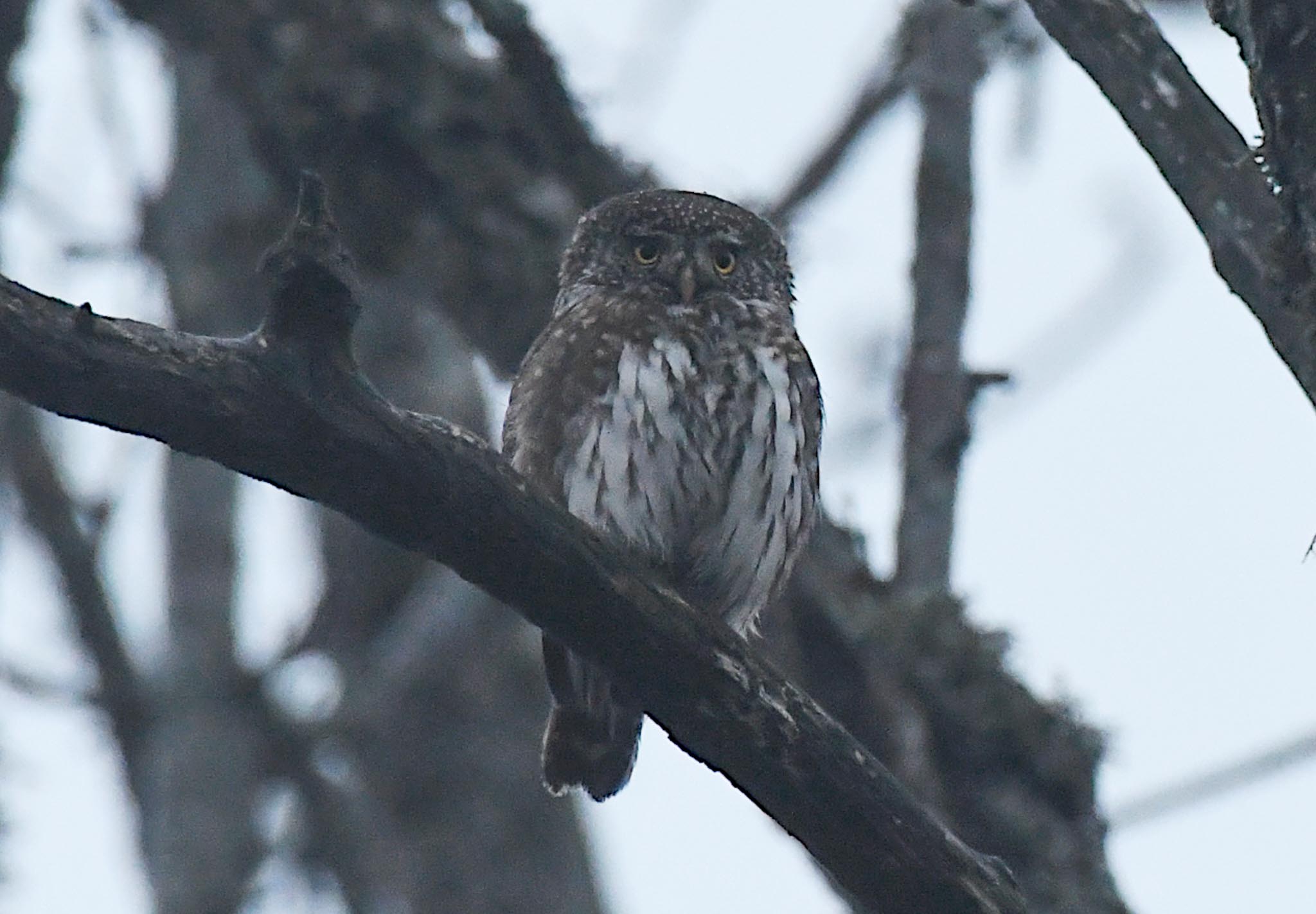
We stood and listened to it for a while and some distant Cranes started bugling too. The light started to improve a little and the Pygmy Owl flew back over and into the trees behind us again – it was hard to appreciate just how small it was perched in the scope, but as it flew past us we got a better sense, not bigger than a Starling. It flew back across the track and into a bare tree in the clearing where it perched calling for a while, then flew back to its favoured perch. A good start to the day, it was time for us to head back.
After breakfast and a short break, we set off again at 7.40am. A pair of Cranes were in the field by the access road, close to the hotel. It was only about half an hour’s drive from here over to Saaremaa harbour, but as we got closer to the coast we drove into more misty low cloud and it started to rain lightly. As we pulled into the harbour, we were (pleasantly) surprised to see a large raft of Steller’s Eider very close to the parking area, in the shelter of the harbour wall. We had to be careful not to disturb them, or any of the other ducks with them which might spook more easily, so we got out very quietly at the back of the car park, leaving the doors open so as not to make any loud noises. Thankfully they just swam a short distance further out as we enjoyed great views.
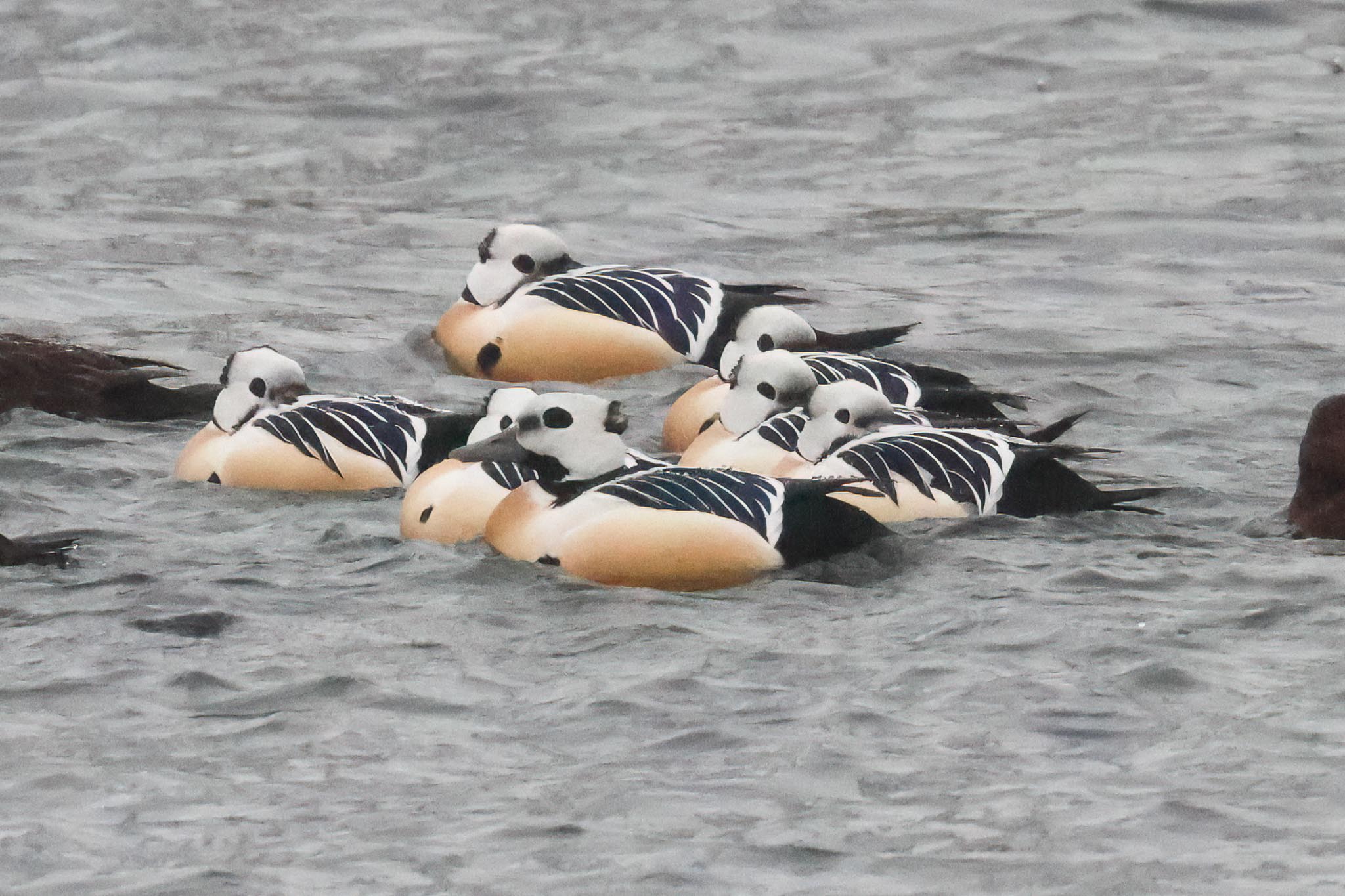
We counted 66 Steller’s Eiders today, including 36 adult drakes and 3 first winter males, many more than we were expecting as there had been only a maximum of 4 seen here so far this winter, so we were very lucky. Mostly they were just synchronised sleeping, which is what they do when they are close in here, but occasionally one would wake up or small groups would run into each other and peck and squabble briefly before going back to sleep. One it was clear they were settled, we walked down closer to the edge, and got them in the scopes using the cover of a picnic table, so we could really appreciate the finer details of their smart plumage.
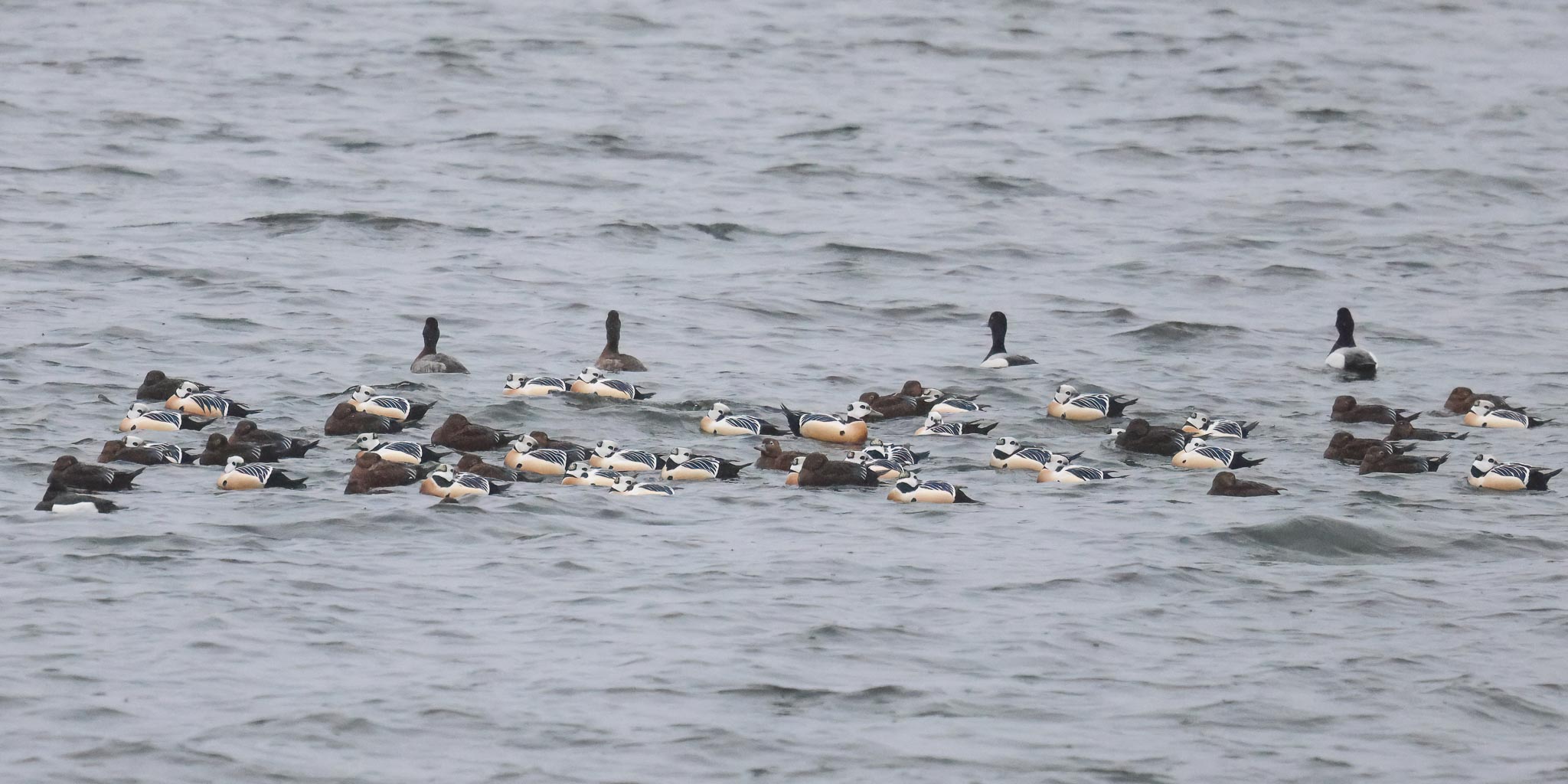
There were a few other ducks in the raft with the Steller’s Eiders, several Long-tailed Ducks, including some smart drakes, and a few Greater Scaup and Tufted Duck. Scattered around the harbour there were more Long-tailed Ducks, several Goosander and Goldeneye, a few Coot and Cormorants. Scanning with the scopes we found three or four Red-breasted Merganser further out and a single immature drake Common Scoter beyond the far wall of the harbour. A small flock of Goldcrest moved through the juniper trees on the edge of the parking area, presumably migrants stopping off on their way back north, and a line of about twenty Bewick’s Swans flew over.

The Steller’s Eiders seemed perfectly settled, until they were spooked by a Grey Heron flying past and took off. They flew off behind the harbour wall but came straight back round and landed again just a little further out from where they had been. They seemed to be settled once more but after just a few minutes, unprompted they then flew again and we watched them heading more strongly out to sea.

We moved on and drove round towards Undva to see if we could find any more Steller’s Eider – there are usually larger numbers off here, but the views are typically much more distant – and any other ducks offshore. A couple of Jays flew across the road on the way and just as we got there it started to snow now, although light at first. We took a track down to the edge of the bay and a couple of Cranes flew up off the shore ahead of us as we arrived and two Skylarks fluttered up singing as we got out. We scanned the sea but there was no sign of the Steller’s Eiders here.
There was a good selection of other wildfowl though, several Shelduck, more dabbling ducks closer inshore including small group of Teal, a single Wigeon and three Gadwall and a couple of Pintail flew past. Further out on the water, we found small rafts of Scaup and Common Scoter, and larger numbers of Long-tailed Ducks mostly across the far side of the bay. A couple of Oystercatchers were standing on the shore, piping occasionally.
It was not forecast to snow here this morning but it was starting to fall more heavily now, so we got back in the minibus and drove a little further up the shore of the bay to try from there. The leaders bravely got out to scan while the rest of the group sensibly stayed in the warm, but the visibility had deteriorated now in the snow and we couldn’t see far offshore. We had enjoyed such fantastic views of the Steller’s Eiders this morning in the harbour, so thankfully it was not essential that we find them here, so we decided to move on and try somewhere else. A small group of Ringed Plover were out on the beach and flew up as we got back in the bus.
As we drove back inland, the snow started to ease off again, but the wind was beginning to pick up now. We noticed a flock of thrushes in a field, so we pulled up to look and found a mixed group of at least 30 Fieldfare and 6 Redwings (the first record of Redwings for Estonia this spring and about 10 days earlier than the average first arrival date), along with two Mistle Thrushes and a couple of Blackbirds. Further on, a small flock of finches flew up from a grassy area by the road as we passed, so we turned around to check them out. They were mainly Goldfinches but there was at least one pale-looking Redpoll in with them. Unfortunately they wouldn’t settle in the wind and kept flying further back, and even though we tried to follow them down a track they disappeared out of view.
Next we pulled up to look at some geese in a field by the road, which were mainly Greylags but in with them were four Barnacle Geese and a couple of Tundra Bean Geese too. As we were passing yet another pair of Cranes in a small bog, we noticed that one was colour ringed so we stopped to try to read the rings. Unhelpfully, first the birds walked behind some low bushes where we couldn’t see their legs, then another car came up behind us and we had to move off the road, at which point the Cranes took off. We thought we had only managed to see the colour combination on one leg, white-yellow-white indicating it had been ringed in Estonia but checking photos we had captured the other leg too – it had been ringed in June 2015 not far away, and a month ago was last seen in Spain!
We made our way down to the main town on the island, Kuressaare, where we first stopped at a petrol station to refuel and to use the facilities. Then we drove into town and over to the restaurant for lunch. After a cold morning, the delicious Norwegian fish soup was very welcome, followed by coffee and a large slab of cake. The snow was still light when we came back out but unfortunately it quickly deteriorated again and it was now getting much windier too.
We drove up to the old harbour first, where we could see a distant White-tailed Eagle perched on a large block of ice on the shore and a couple of more distant Smew out on the sea, but no sign of any closer ones in the harbour channel. Then we turned onto a rough road and followed it round the coast. When the snow eased off we were able to get out and scan, so we stopped where we had a clear view of the sea. There were lots of wildfowl along the shore, notably more Pintail, Wigeon and Teal, with more Goosander, Goldeneye and a few Smew out on the water beyond, and there were Lapwings and a small group of Ringed Plover on the mud. Despite the inclement weather, it was amazing to watch migration in progress, birds arriving off the Baltic Sea – a couple of small groups of Cranes came in off the sea, along with a few White-fronted Geese, small parties and a larger flock of Skylarks, and a single Snow Bunting flew over our heads calling. Two Stock Doves came over too, the first we had seen, together with a single Feral Pigeon.
We carried on along the coast, but there were fewer ducks in the next couple of bays. When a large flock of birds flew across the road in front of us, we realised they were all Great Tits. We could see more in the trees, moving through quickly, obviously recently arrived over the sea. A line of a dozen or more Grey Herons along the shore looked like they were also likely fresh in too. There was nowhere convenient to view the coast further along, so we looped back and pulled off by a small picnic area. A couple of White-tailed Eagles were perched on distant rocks. There were still a few ducks here, three Red-breasted Merganser and some Smew including three which flew in and landed a bit closer. More Great Tits moved in through the bushes past us and a trickle of Skylarks continued overhead, a Robin was skulking in bushes, probably all migrants moving. A Northern Bullfinch flew over calling, sounding a bit like a toy trumpet.
There was no sign of any significant let up in the weather, so we started to make our way slowly back. We stopped to look at a flock of about 110 Jackdaws which were feeding in a field by the road – there was quite a bit of variation, some showing significantly more of a white collar than others, possibly indicative of intergradation between Nordic monedula and more eastern soemmerringii here. We pulled up again to photograph another pair of Cranes very close to the road before continuing on a short distance past Loona and on to Kihelkonna, where we thought we might have a quick look for Hawfinch around the village. We parked and got out, but it was cold and windy, still with light snow falling, and late in the afternoon too it was perhaps no surprise that it was all very quiet in the trees.
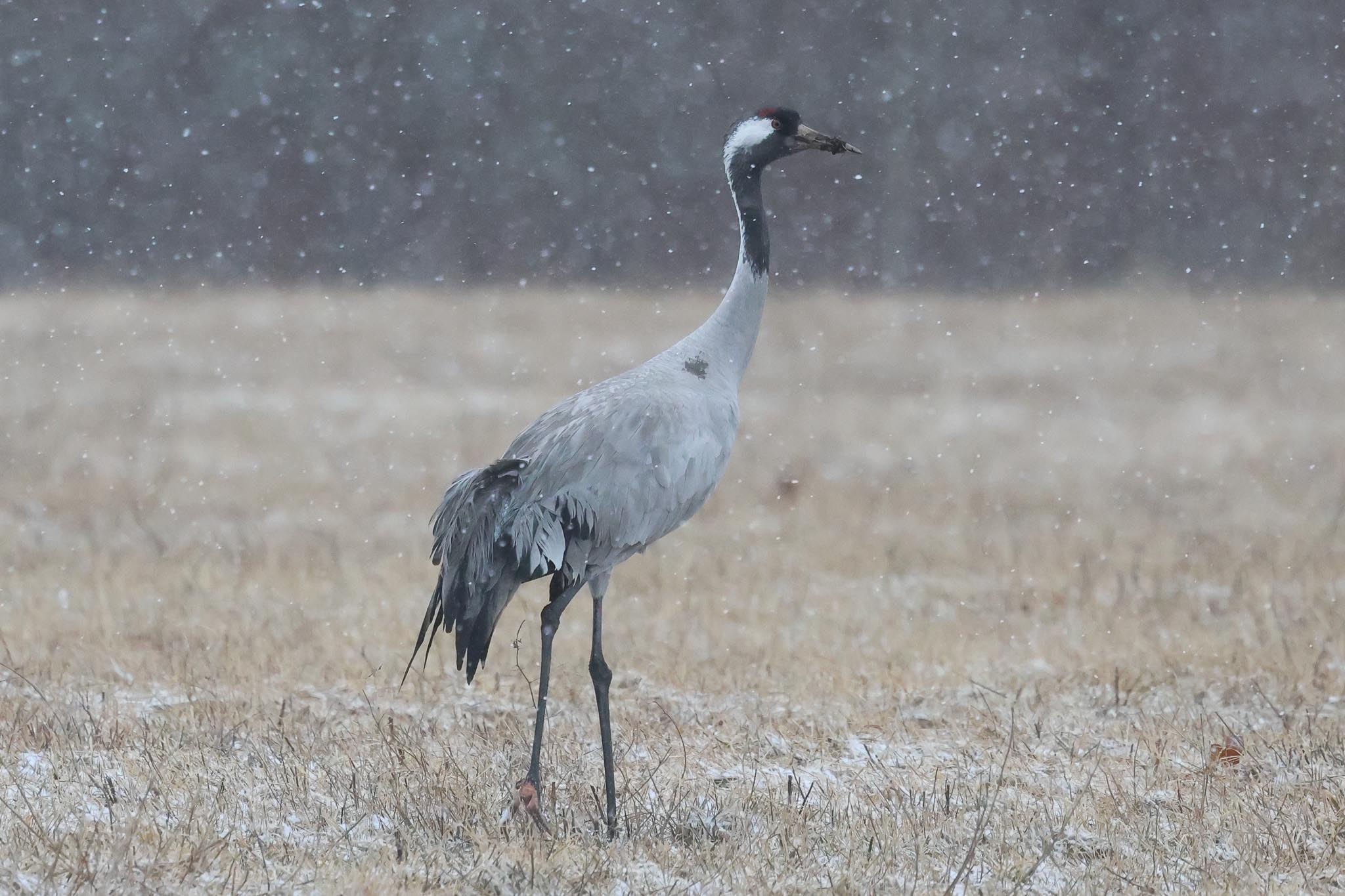
One of the group realised he had lost his hat and gloves, and thought they might have fallen out when he opened the door to take photographs of the Cranes earlier, so we drove back and found them lying in the middle of the road – rather damp roadkill now! Then we headed back to Loona for a hot cup of tea, a slightly early finish but it would give us time to pack up – we were moving on again tomorrow, back to the mainland and would have a long day ahead
MONDAY 18TH MARCH
For those who wanted, we met for an early walk around the hotel grounds for about 15 minutes before breakfast. It was crisp and cold and rather quiet at first. A male Northern Bullfinch flew in trumpeting and perched in the top of a tree above where the minibus was parked. There were lots of noisy Greylags gathering in the fields next door, and Cranes calling in the distance. As we walked round, several Blackbirds flew up out of the trees – possibly migrants stopping off here overnight, a pair of Marsh Tits and several Great Tits appeared and two Siskins flew over calling. As we walked back up towards the hotel, another group of four Bullfinches flew in and landed in the top of the trees and over breakfast, we watched at least seven of them dropping down to feed on the frozen ground in the frosty leaves.
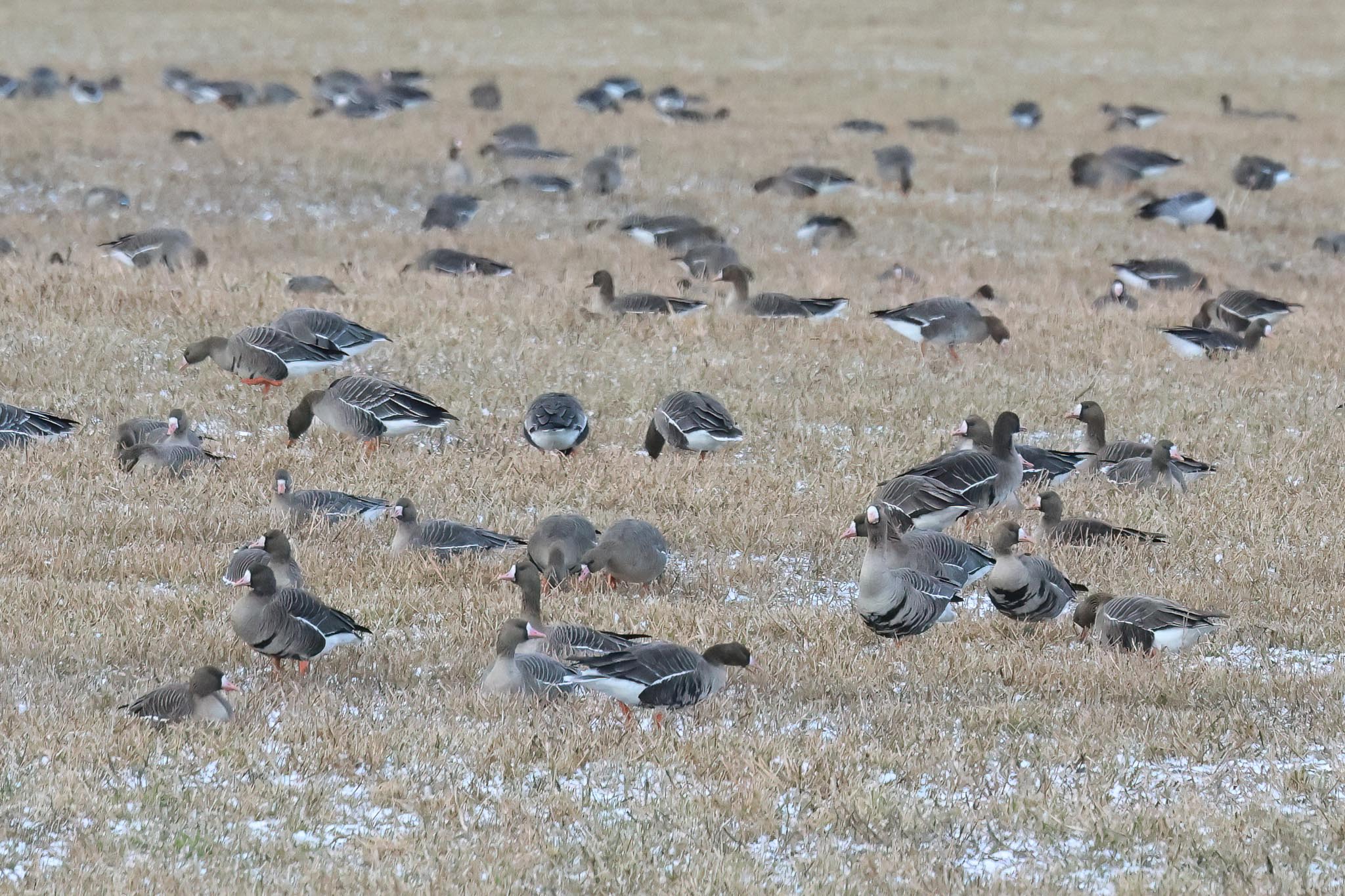
It was a driving day today and we would be leaving Saaremaa island and heading back to the mainland. We set off straight after breakfast and hadn’t gone far when we came across a large flock of geese in a field by the road. We pulled up for a quick look through – there were at least 1,000 White-fronted Geese, 50 Tundra Bean Geese and 30 Barnacle Geese in the one group, an impressive gathering but we couldn’t find anything different in with them. It had been dry first thing and there was even a brief sunny spell as we drove across the island but it quickly clouded over again and as we got towards coast, we started to get a few snow flurries once more. The sea off the causeway to Muhu was still mostly frozen and over the far side, we spotted two White-tailed Eagles on the ice with a fish, attended by a circle of hungry-looking Hooded Crows. As we pulled up, the adult flew off leaving the juvenile behind to finish off the fish.
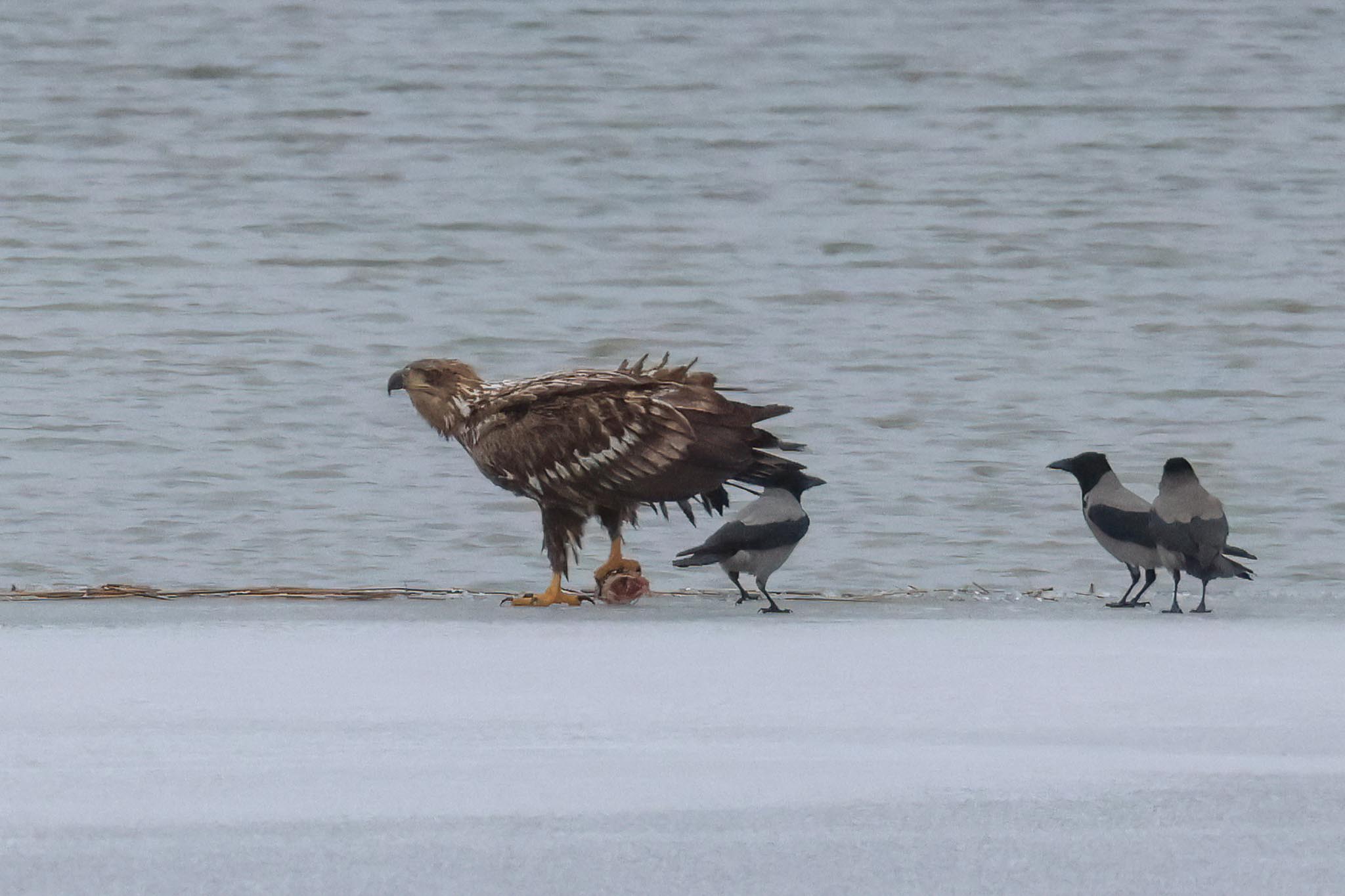
The ferry was on time and departed with typical Estonian efficiency. Another White-tailed Eagle was out on the ice as we pulled out from the Muhu side of the channel and a drake Smew flew over. As we sailed out into the open water, several groups of Long-tailed Ducks took off from the sea right in front of us, and we could see more huge flocks, clouds flying low over the water to the right and left. An amazing sight – at least 2,500-3,000 Long-tailed Ducks in total. As we got to Virtsu the other side, a Grey Seal was in the water ahead of us briefly.

We were heading south-east to Pärnu this morning, which would be our base for our last two nights, but with birding stops on the way. Not far, we turned off to look for Black Grouse again, where we had tried a couple of days ago but this time in the morning. A pair of Cranes were standing out in the frozen bog, as we passed – nice to see them in typical breeding habitat – and in the fields the other side, we quickly found four male Black Grouse, hunkered down in the grass with light snow still falling.

Back to the main road, we hadn’t gone far when we found more Black Grouse in another field, this time another four males and a single female, a Greyhen. A large flock of about 150 Skylarks flew up too and the fields here held several more pairs of Cranes too.
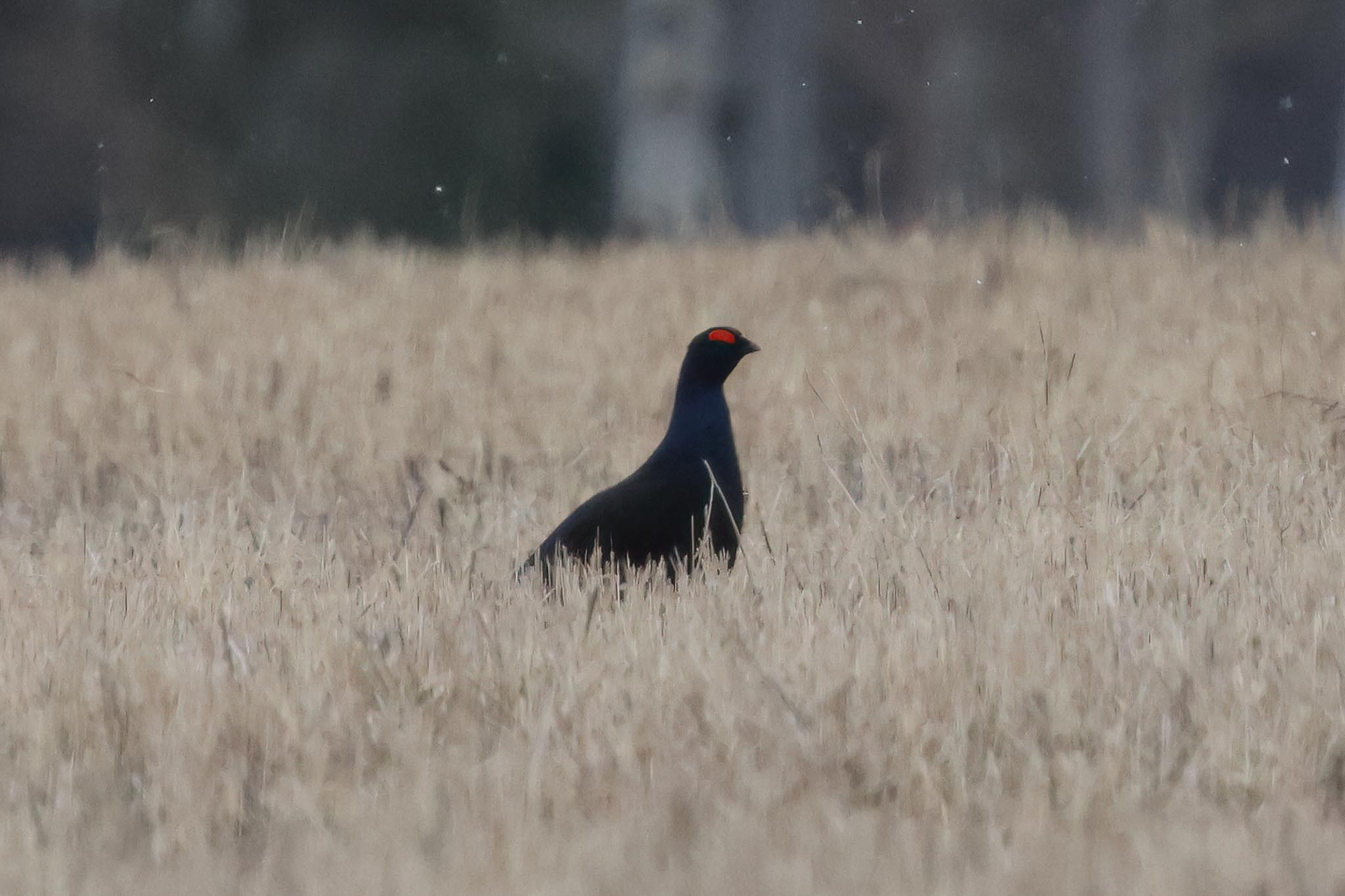
We stopped next at a regular site for White-backed Woodpecker, where Tarvo had seen them just a few days ago. It had stopped snowing but it was cold with a bit of bite to the breeze now. A pair of europaea Nuthatches appeared first, the white-bellied male feeding on the trunks next to the road, then a ubiquitous Great Spotted Woodpecker, followed by a smart pair of Grey-headed Woodpeckers, but there was no sign of their White-backed cousins this morning. The weather was not ideal for looking for woodpeckers.
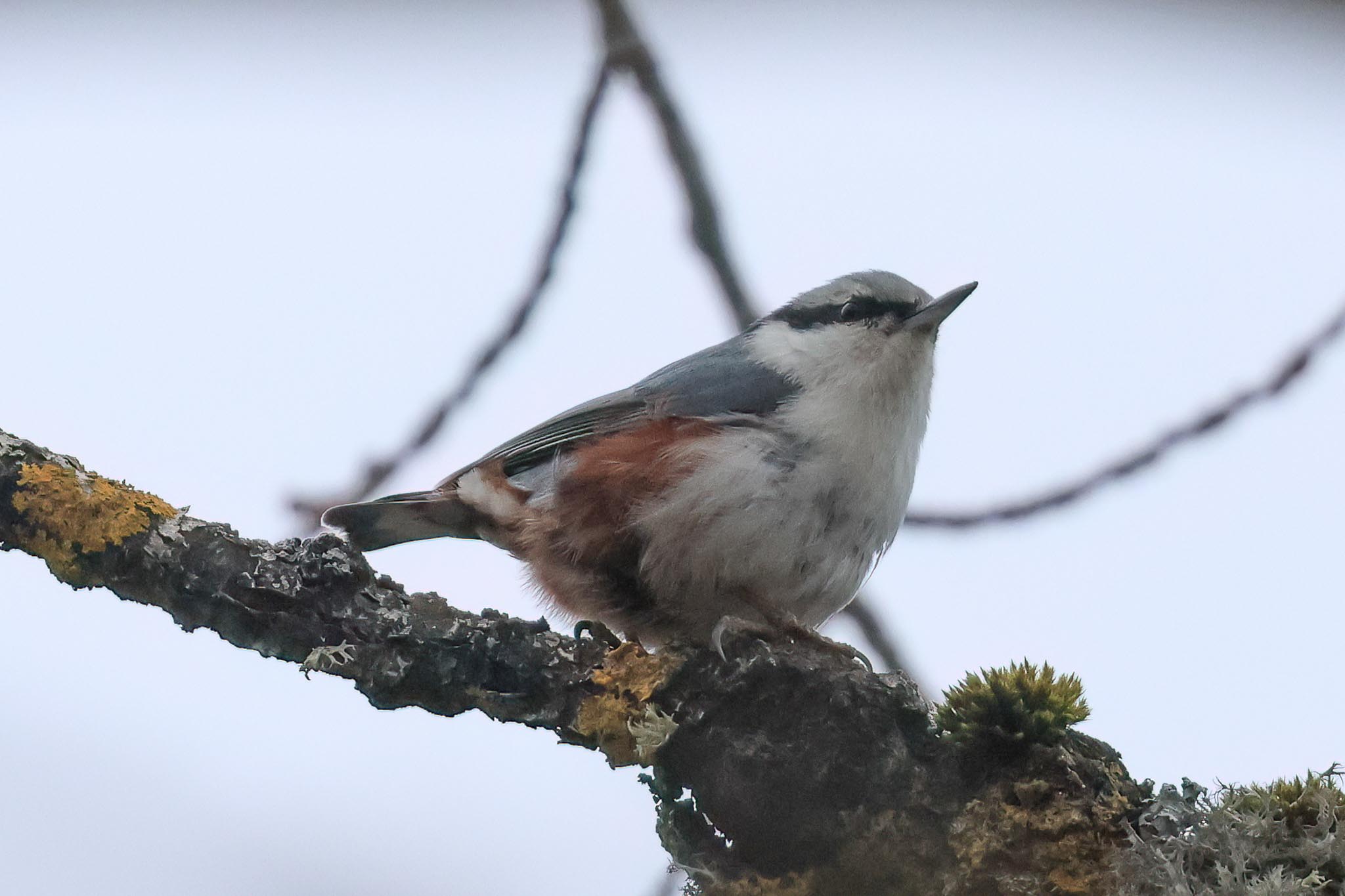
Closer to Pärnu, we could see a large flock of swans in a field so we turned off onto a convenient track which took us much closer, where we could get out and get them in the scopes. Among the 369 Bewick’s Swans we found two with satellite tracking collars (we noted down the codes – still awaiting details at the time of writing), and a smaller number of Whooper Swans too. There were at least 900 White-fronted Geese, with a smaller number of Tundra Bean Geese, 20 Barnacle Geese and 6 Canada Geese and looking through carefully, we found a single Pink-footed Goose in with them. There were eighteen Cranes feeding in with all the wildfowl too. Very impressive to see such large numbers of migrants here, stopping off to feed before continuing their journeys north. Several Yellowhammers and a few Reed Buntings came up out of the stubble in front of us, along with a small flock of Linnets.

We had our last quick stop to try for Middle Spotted Woodpecker in a park in the middle of a small village, but although we found at least four Great Spotted Woodpeckers in the trees there was no sign of any other woodpeckers today. Lots of birds were coming down to some feeders on the edge of the wood – Blue and Great Tits, Nuthatches, several Greenfinches. A small flock of House Sparrows was feeding on the ground below, with several Tree Sparrows in with them. Just outside the village, we passed another large flock of geese, mainly White-fronted Geese and lots of Barnacles, but we had no time to stop to check through them now, as we had a reservation in town for lunch.

As we were driving into Pärnu, we were just thinking that the park in the centre looked good for woodpeckers when Tarvo spotted two Middle Spotted Woodpeckers on a tree trunk right by the road. Thankfully we could stop quickly, we piled out of the minibus and watched them feeding low down on the trees, walkaway views. After our unscheduled stop, we were late getting to our hotel and went straight in to the restaurant for lunch. Afterwards, we then had more time to check in and then an opportunity to settle in.

Later in the afternoon, we headed out again and into the forest. We were mainly trying for owls, with another chance for woodpeckers but it was not an ideal time of day for the latter now. At least it was still and had stopped snowing but it was rather cold, with a light dusting of fresh snow. We were hoping for more views of Pygmy Owl in better light, but there was no sound of any calling from the trees, just a pair of Willow Tits and a Great Spotted Woodpecker at the first spot we tried. Driving further in along the snow-covered tracks a couple of Common Buzzards flew across ahead of us, and in the next clearing we stopped to try again. A pair of Crested Tits were calling high in the trees here, another couple of Great Spotted Woodpeckers appeared and a young White-tailed Eagle drifted over. Further on, a couple of flocks of Chaffinches flew over and another clearing produced just another Great Spotted Woodpecker.
It was time to start looking for Ural Owl, so we drove back round to where we had stopped first and we were just listening for owls when Tarvo heard the ‘kik’ call of a White-backed Woodpecker. We couldn’t see it at first, but then it flew out of the trees and over our heads. Frustratingly it kept landing just out of view, or where it was hard to see, but eventually came out onto a tree in the open and started drumming. Great views now, finally. A Black Woodpecker flew over the track further down too and across behind the trees the other side, we could hear Grey-headed Woodpecker calling and several Great Spotted Woodpeckers as well, a surprising amount of woodpecker activity here for this late in the day. Two more White-tailed Eagles flew over.
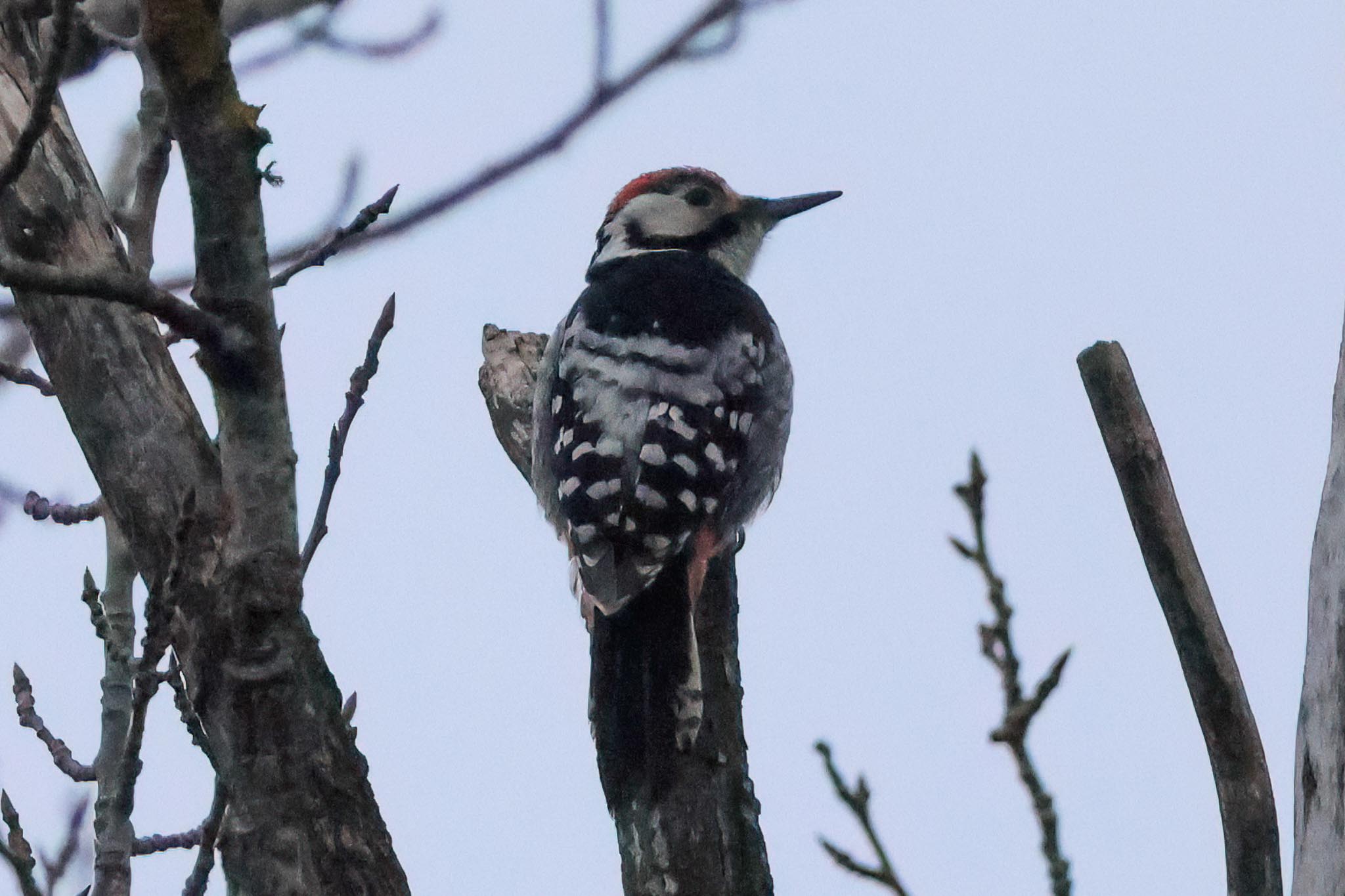
There was still no sound of any Ural Owls though. We tried the two other clearings but they were quiet too, so we drove over to another site about 20 mins away. There was deeper snow on the tracks and no owls calling here either. It was getting dark now – maybe with the snow today and the drop in temperature the owls had switched back to winter mode. It was time to head back. On the way, a Brown Hare ran down the road ahead of us in the headlights, executed an impressive jump across the ditch, and then out across the field the other side, and a little further on, a Red Fox disappeared into the trees on the verge. We got back to our hotel in Pärnu in time for a late dinner tonight.
TUESDAY 19TH MARCH
After breakfast, we headed back into the forest where we had been last night looking for owls, this time trying to find woodpeckers and particularly Three-toed Woodpecker. We stopped at a crossroads in the tracks and walked deeper in. There were some canine tracks in the fresh snow from yesterday but there were fresh vehicle tracks too, so we presumed it must have been a dog at first. At the next crosstracks, we found the truck and caravan which had made the vehicle tracks, but the canine tracks continued straight on past, probably before the vehicle had arrived, and down the smaller track through the trees which we now took. The very purposeful and direct nature of the prints now suggested they were more likely made by a Wolf. We found some fresh deer tracks too, and those of a Raccoon Dog which crossed a ditch on a fallen log and came across the track.
We stopped halfway down and listened. It was fairly quiet at first – all we could hear were Great Spotted Woodpeckers and we managed to see one or two of them in the trees too. It was much milder than yesterday and still and slowly activity started to pick up a bit more. A few tits began to appear, Coal Tits high in the pines, a nice lower pair of Crested Tits which finally gave us better views, and we heard Long-tailed Tits, and a Treecreeper appeared climbing up the trunks. We could hear the deep whooping calls of Stock Doves too and found one or two perched distantly in some large deciduous trees further back, along with a Woodpigeon.
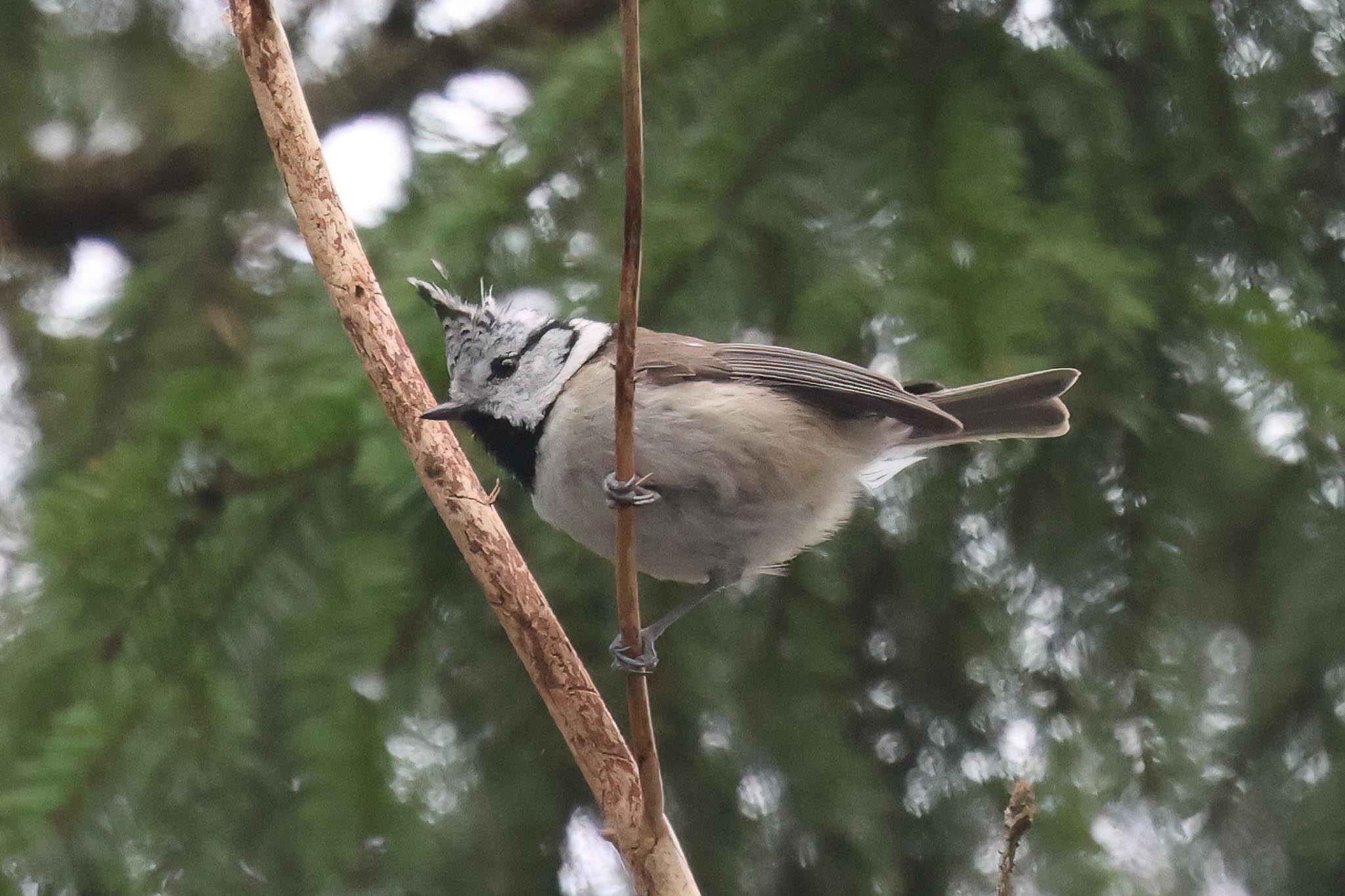
Then we heard the distant drumming of a White-backed Woodpecker, too far away to locate, and when some slower drumming started up a bit closer shortly after we thought it was something different. It sounded more like a Three-toed Woodpecker, but we eventually managed to locate it in the deciduous trees and it was the White-backed Woodpecker again, a female. It flew closer in and over our heads, then came back out and perched in the trees closer to the track. We had a great view in the scopes now, drumming on a dead branch, we could see its ladder back with a solid white patch in the centre.
We walked back up to the minibus and decided to try another spot. We had seen some nice old spruce trees by the main track last night, with some freshly stripped bark on the dead trunks, which looked good for Three-toed Woodpecker, so we drove the short distance further up to check them out. There were at least four Great Spotted Woodpeckers in the trees here when we arrived and for a minute or two it looked like that was all there was but then a Three-toed Woodpecker appeared. It flew in and fed on the trunk of a spindly dead spruce at first, where it was harder to see in all the branches. Thankfully it stayed long enough for us to get it in the scope so everyone could see it, a female with a dark crown. Then it flew across into a large bare deciduous tree right by the track and dropped down onto a thick tall stump where it started to drum. It kept shuffling down to drum on a resonate section of trunk which had split down from the top and then shuffling back up to look around. Fantastic views through the scopes now, so good that we could even count its three toes! When it finally flew further back, we decided to move on.
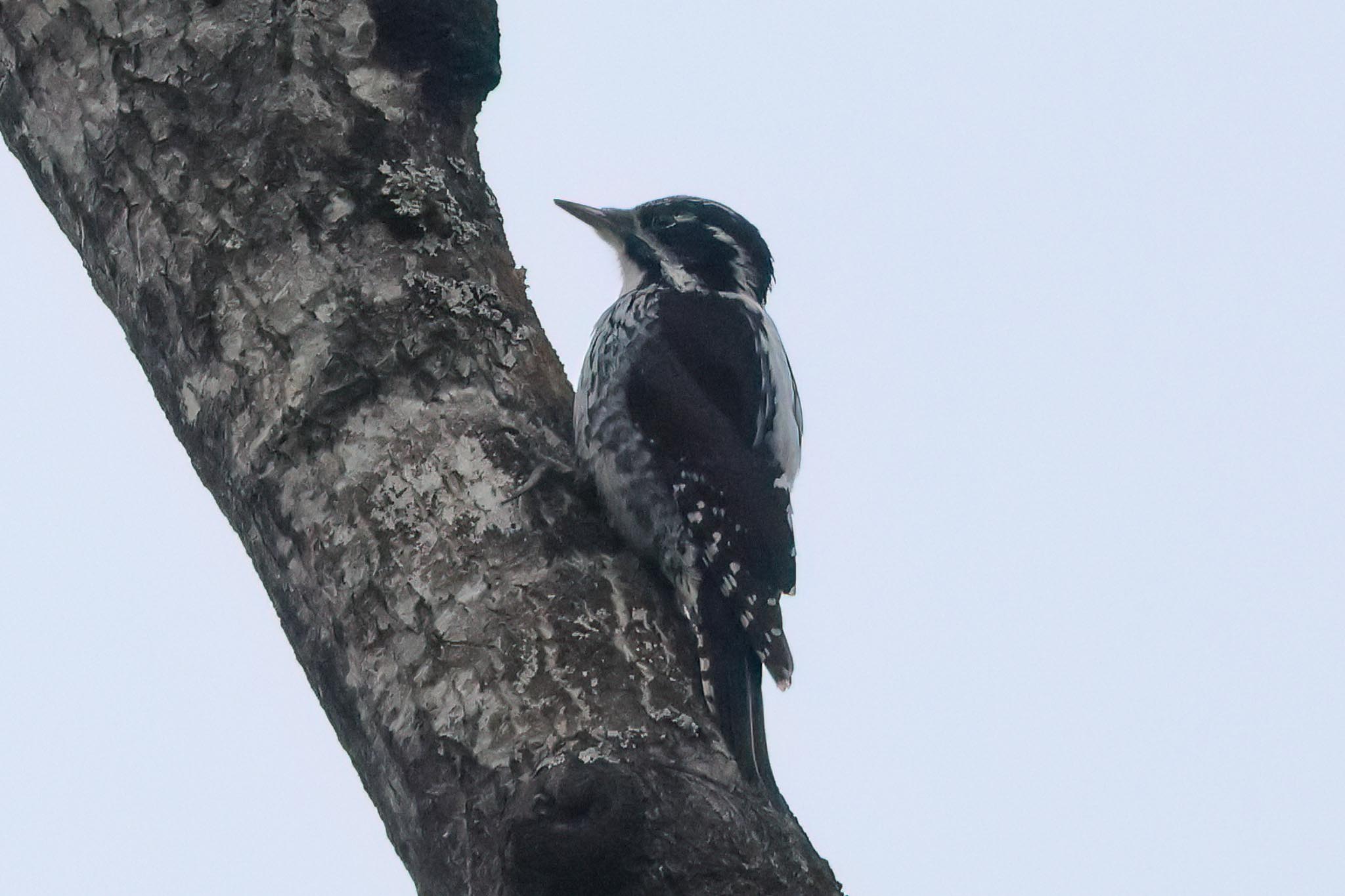
We drove over to the other site we had visited yesterday evening now, to see if we could find any Hazel Grouse. The first place we tried was rather quiet, although we did find the fresh tracks of a young brown bear in the snow here, probably made not long after we had left last night! We moved on a short distance to another block of trees and we were just listening for the grouse when a Pygmy Owl started calling. It was distant, a bit further in, so we got back in the minibus and reversed back to the previous junction, before walking down the track to the edge of the spruce trees. The Pygmy Owl had gone quiet, but we heard Black Woodpecker calling nearby now. We turned our attention to that and it flew straight in and over our heads, followed by a second Black Woodpecker, presumably a pair. A young White-tailed Eagle flew over too.
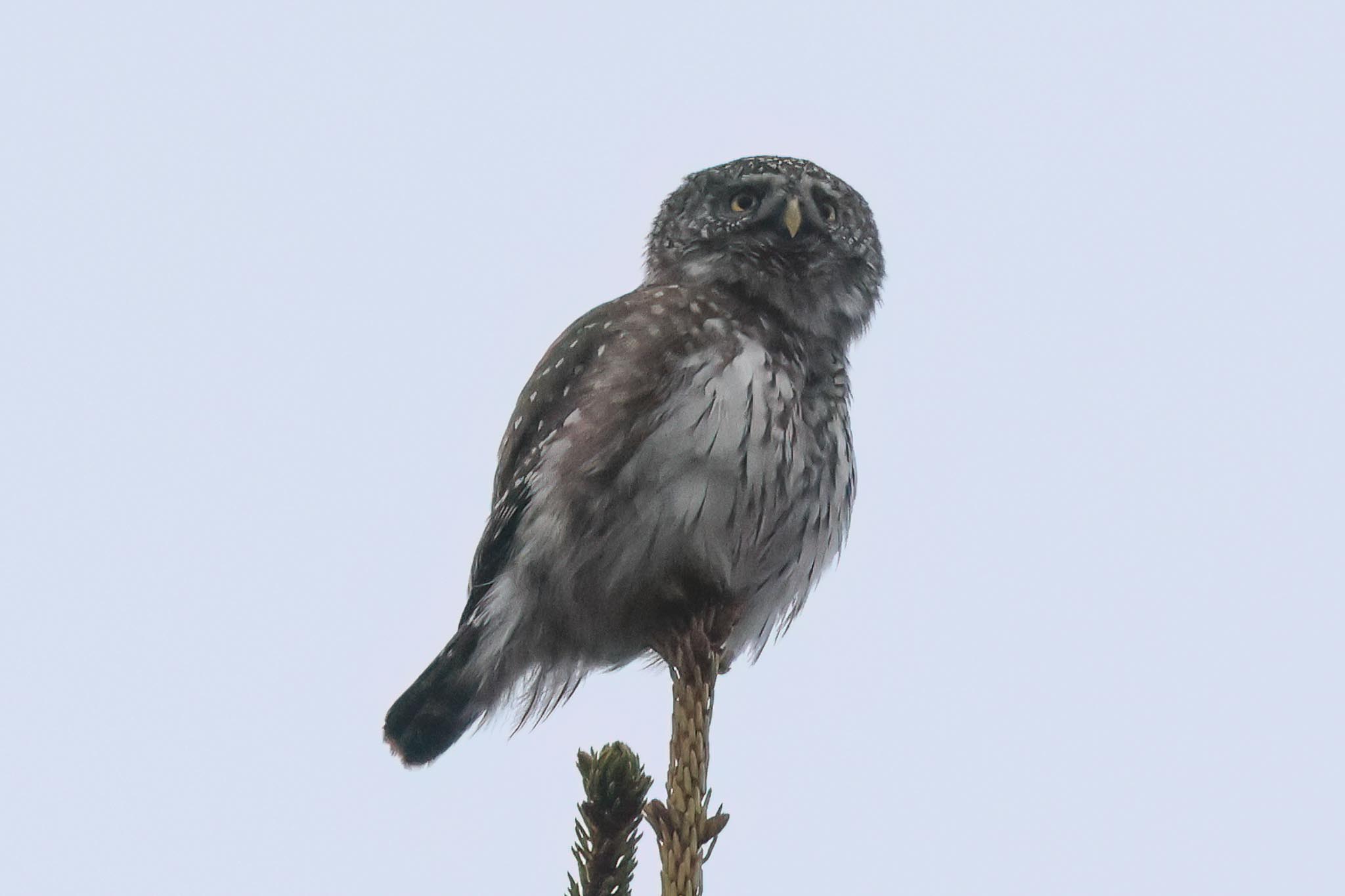
Then the Pygmy Owl started up again, much closer, before flying up into the top of a spruce tree right next to the track. Great views now, and in much better light than the one we had seen the other morning. Lots of small birds started to mob it from the nearby trees, several tits at first, but they were then joined by a small group of Common Crossbills which perched in the treetops above us too. It was amazing just how much difference a few degrees rise in temperature made, the amount of woodpecker and owl activity here today, compared to yesterday.

It had been a wonderful morning but it was now time for lunch, so we headed back to Pärnu and over to a different café today for a bowl of hot soup to warm us up. This particular establishment also does very good cake and everyone chose a slice of something from the excellent selection on display by the till to have with coffee afterwards – too much choice and all too tempting! Then we walked the short distance back to the hotel while Tarvo came round with the minibus. We had some time to rest now before we would head out again this afternoon, but for anyone who couldn’t sit still there was also the option to explore the town.
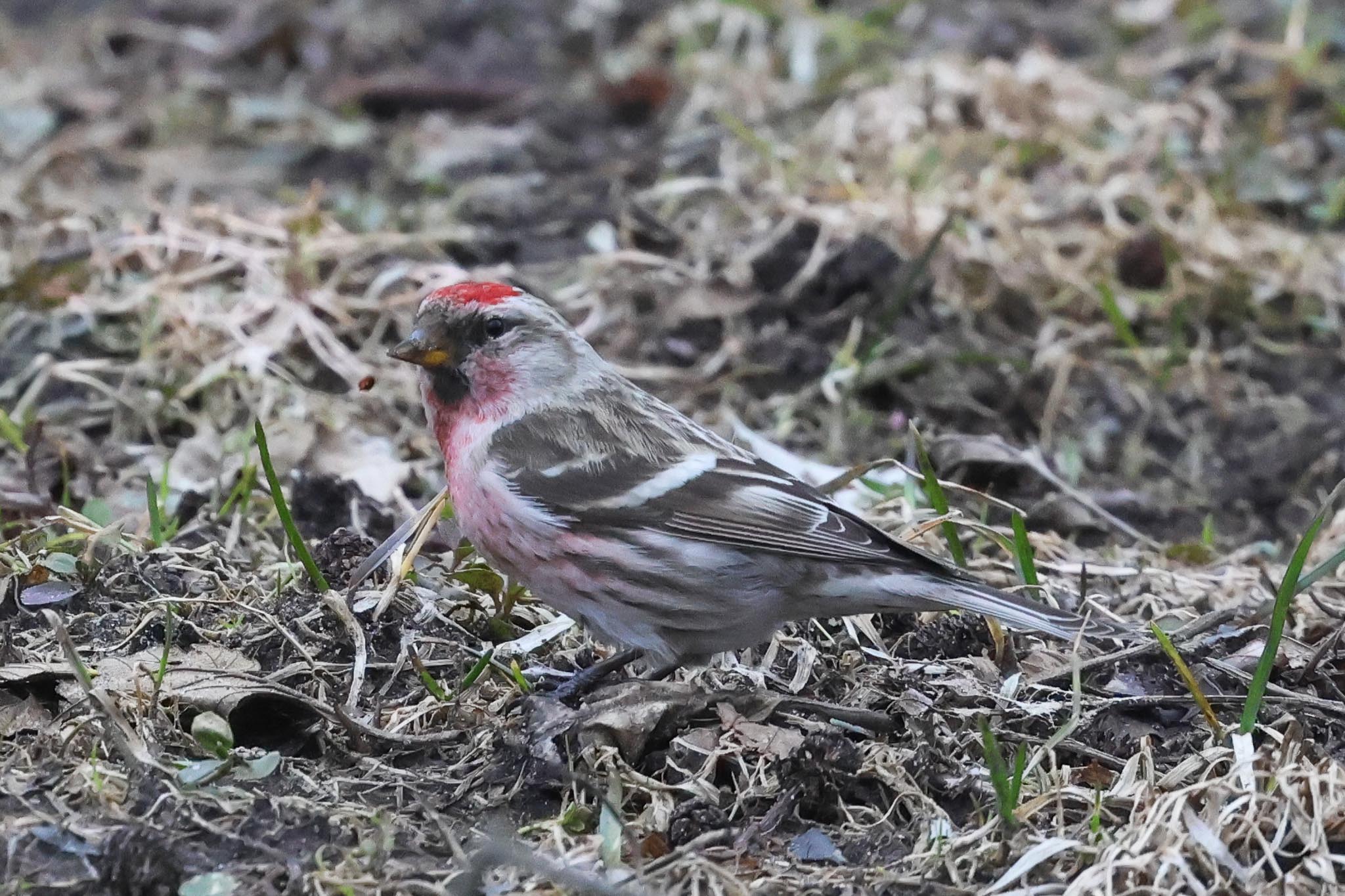
There were some Common (Mealy) Redpolls feeding under some alder trees with a couple of Siskins in a small park nearby, so when we met again we all walked over for a look. A Treecreeper was climbing up the trunk of a tree, of the northern race familiaris here, paler than the ones back in the UK. The Redpolls and Siskins were feeding up in the alder trees now, so we stopped to watch them, including a couple of very smart pink-breasted males.
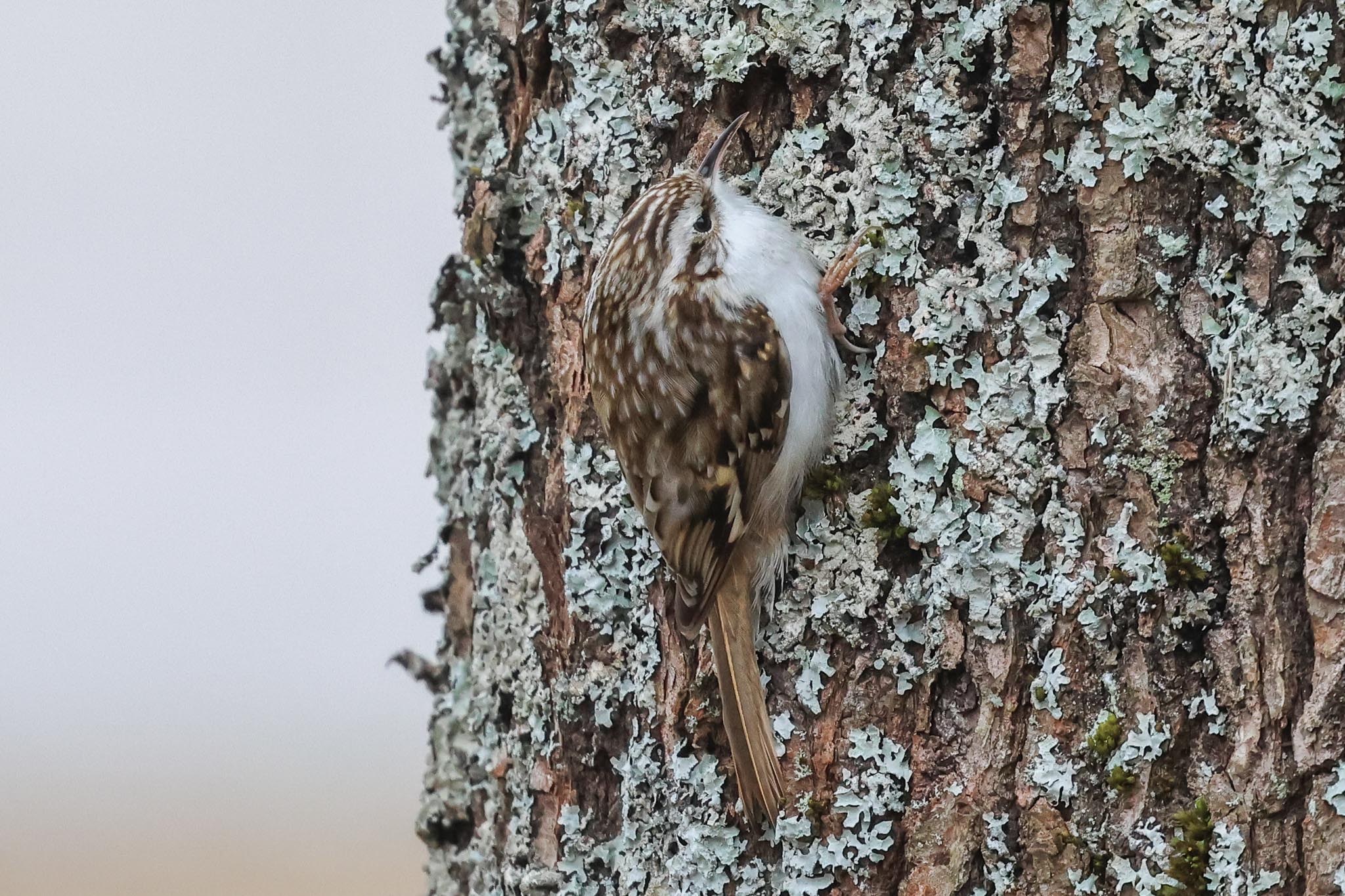
As we drove away from town, we noticed six Cranes in a field by the road so pulled up briefly to check if any were ringed. Two more Cranes flew over towards them and a lone Bewick’s Swan headed the other way, followed by another four. We could see the swans were dropping down beyond a nearby windfarm, and geese were too, so we drove round to see if we could see them. Round the other side we found an old maize field chock full of swans and geese. There were at least 620 Bewick’s Swans here, an impressive number itself, but along with the ones we had seen yesterday it was amazing to think we had probably seen 5% of the western European wintering population in those two groups in two days!

There were a few Whooper Swans too and an amazing number of geese, the majority of them Tundra Bean Geese. With many of them feeding heads down in the tall maize stubble it was hard to say how many there were but Tarvo estimated at least 4,000, with about 500 White-fronted Geese and a few Canada and Barnacle Geese too. An amazing sight, all stopping off to feed here on their way north and east for the breeding season. Several Yellowhammers and Reed Buntings flew up from the stubble close in front of us.
We had seen several empty White Stork nests as we drove round the countryside over the last couple of days and Tarvo had seen reports that the first birds were just starting to return but we were not expecting to see any at this early stage of the spring. As we drove on now past the rubbish tip, we found three White Storks in the field opposite so we pulled up to look.

Our main target this evening was to try again for Ural Owl and with the warmer temperature and still conditions we thought we might be in with a better chance, so we headed over into a different area of forest now. We still hadn’t seen Hazel Grouse too, so we tried again for those first in a regular spot but there was no sound of them once more. We drove on along the track and we were just pulling in to park opposite a clearing where we would try for the owl when a Hazel Grouse flew across the road in front of us. It disappeared into the trees the other side and we got out quickly and quietly, but despite our best efforts we couldn’t find it again. We could hear it calling, but it refused to come out, so we eventually had to admit defeat and turned our attention back to owls.
We walked down to the edge of the clearing and most of us were looking out across the open space when one of the group asked what was the large grey bird which had just flown across the track between the trees behind us. We turned and a Ural Owl started calling! It remained stubbornly hidden from view for the rest of us for some time, calling occasionally – it was possibly still a bit too light for it to show itself properly. We backed off and stood further down the track and waited patiently. It took a bit of time, but thankfully while there was still very good light the Ural Owl finally flew through the trees, out from the denser spruces where it was hiding and landed in the bare deciduous trees closer to the track. Now we had an excellent look at it through the scopes – we stood and watched it for some time, as it started to get dark, before eventually we had to tear ourselves away. Driveaway views!

The first Tengmalm’s Owls are just starting to return to their territories, so we had a speculative try for one a short drive back along the track on our way back. Unsurprisingly, there was no response but we did hear another Pygmy Owl in the distance and then a second started up behind us and flew in to where we could just see it in the last of the evening’s light. One or two roding Woodcock flew over the trees calling. As we drove back to Pärnu, another Red Fox ran across the track in front of us and then it started to spit with drizzle, perfect timing. What a great last day it had been.
WEDNESDAY 20TH MARCH
After breakfast, we packed up the minibus and set off on the long drive back to Tallinn. There had been a light dusting of fresh snow overnight, it was colder again today and we drove through several more flurries. There were the usual birds in the fields on the way, Lapwings and Skylarks, a couple of Yellowhammers on the wires, Hooded Crows and Ravens, Common Buzzards perched in the trees and several Eurasian Jays flying across the road. On our way in through the suburbs of Tallinn, a Red Squirrel ran along a wire over the road. It took a little under two hours to get to the airport, where we bade farewell and thanks to Tarvo.
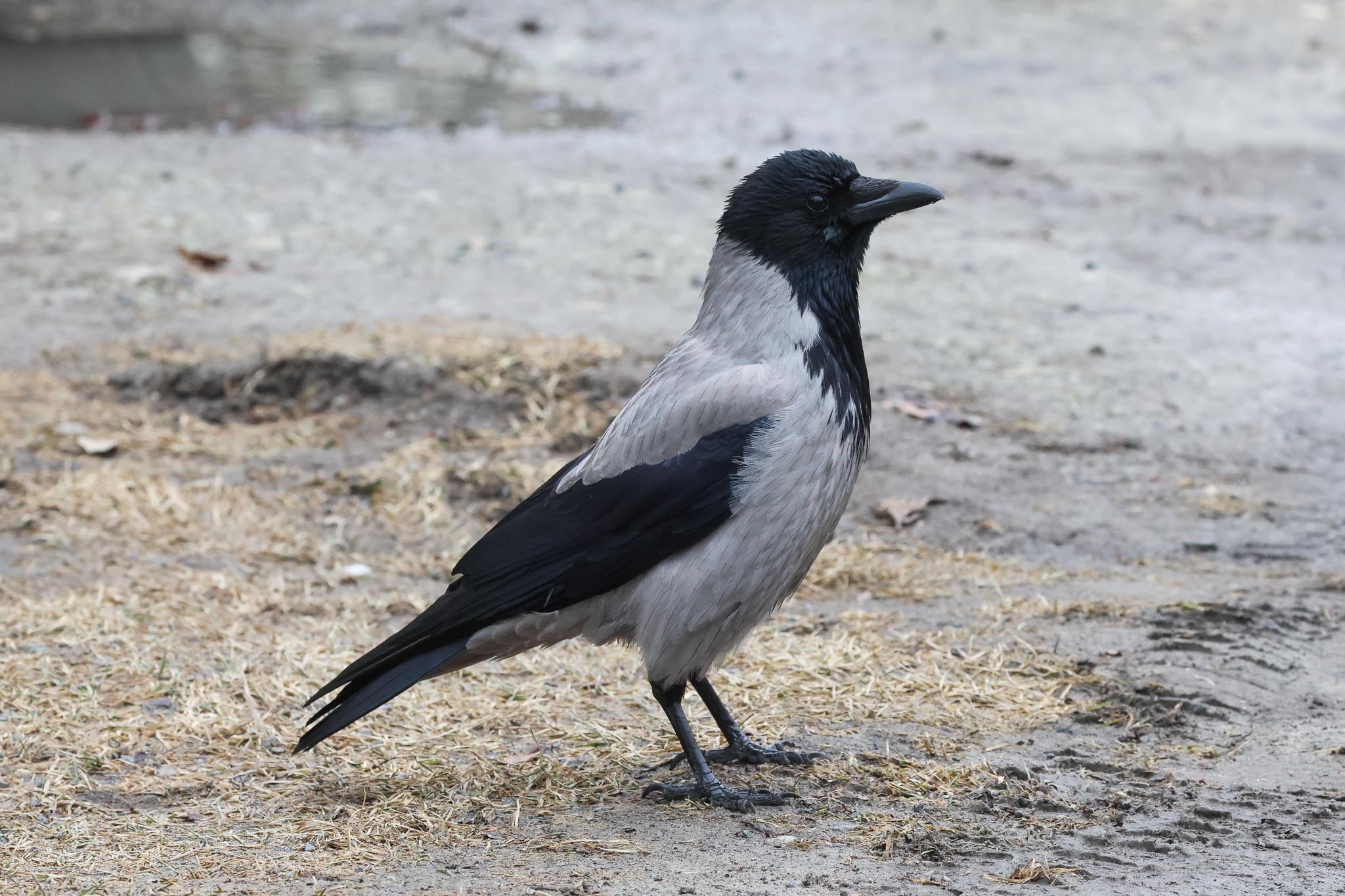
Passage through the airport was fairly seamless, our Wizz Air flight took off on time and we were ten minutes early arriving into Luton. We had to wait for a bus to take us to the terminal and it was a bit of a shock to find it sunny and warm, a balmy 13C, outside. Our bags were waiting for us on the carousel and we said our goodbyes before setting off on our respective journeys home.
